Key developments on July 10:
Rubio discusses 'new approach' to ending Russian war in talks with Lavrov despite US 'frustration'U.S. reportedly resumes some arms deliveries to Ukraine after pause2 killed, 25 injured as Kyiv slammed with drones, ballistic missiles in Russian mass attack against Ukraine for 2nd night in rowZelensky urges 'Marshall Plan-style' support for Ukraine at Recovery Conference in Rome
U.S. Secretary of State Marco Rubio said he discussed a "new and different approach" to ending Moscow's war in Ukraine during a meeting with Russian Foreign Minister Sergey Lavrov in Malaysia on July 10, speaking at a follow-up press conference.
"I wouldn't characterize it as something that guarantees peace, but it’s a concept that, you know, that I'll take back to the president (Donald Trump)," Rubio said, without giving further details.
"We're going to continue to stay involved where we see opportunities to make a difference."
Rubio's remarks came after a meeting with Lavrov, which took place after another Russia's large-scale drone and missile strike on Ukraine.
The diplomatic push continues amid efforts by Trump to broker a ceasefire and peace agreement in Ukraine. However, despite Moscow's intensified attacks, the Trump administration neither imposed new sanctions on Moscow since taking office nor approved additional aid packages.
U.S. reportedly resumes some arms deliveries to Ukraine after pause
The Trump administration resumed shipments of at least some weapons to Ukraine after a Pentagon-ordered pause, Reuters and the Associated Press reported on July 10, citing undisclosed U.S. officials.
The full content of the resumed shipments is not immediately clear, though officials told the U.S. media they include 155 mm artillery rounds and GMLRS guided rocket munitions.
U.S. Defense Secretary Pete Hegseth reportedly ordered a halt on some of the ongoing deliveries, including Patriot air defense missiles and precision munitions, last week amid a review of U.S. stockpiles.
The move apparently took Ukraine, European partners, and the U.S. State Department by surprise. CNN reported that Hegseth did not consult with the White House before ordering the pause.
According to Reuters, the paused shipment included 30 Patriot missiles, 8,500 155 mm artillery shells, 250 GMLRS rockets, and 142 Hellfire air-to-surface missiles.
The State Department and the White House confirmed earlier this week that a decision has been made to continue providing arms to Ukraine, without providing additional details.
When asked during a press conference on July 10 about reports of a recent pause in U.S. military aid to Ukraine, U.S. Secretary of State Marco Rubio said the situation had been "mischaracterized." He added that assistance to Kyiv is proceeding according to the established schedule.
"It was a pause pending review on a handful of specific type munitions... It was a very limited review of certain types of munitions to ensure that we (the U.S.) have sufficient stockpiles," Rubio said.
"Generally speaking, aid to Ukraine continues along the schedule that Congress appropriated."
2 killed, 25 injured as Kyiv slammed with drones, ballistic missiles in Russian mass attack against Ukraine for 2nd night in row
At least two people were killed and 25 injured in Kyiv as Russia launched a mass attack against Ukraine for the second night in a row, rocking Ukraine's capital and cities far from the front lines overnight on July 10.
At around 1:15 a.m. local time, Kyiv Independent journalists on the ground began reporting explosions in the capital and the buzzing of Shahed-type drones. Reporters said large numbers of drones were flying over the Pechersk neighborhood, a historical district in the city center.
Later in the night, reporters said they heard several dozen explosions and the distinctive sound of ballistic missiles. At least an hour of near-constant explosions rolled through the city.
Blast waves also set off car alarms throughout Kyiv, adding to the roar of drones, ballistic missiles, and air defense fire. Air raid alerts ended at approximately 7 a.m. in Kyiv Oblast.
Ukraine's Air Force issued multiple alerts overnight, warning that groups of Russian drones were targeting regions throughout the country, including the far-western Ternopil and Rivne oblasts.
The attack caused fires at apartment buildings in Kyiv's Shevchenkivskyi and Darnytskyi districts, Mayor Vitali Klitschko reported. Gas stations and garages are also in flames, he said, and medics have been dispatched to the scene.
Two people were killed in the Russian attack, Tymur Tkachenko, head of the Kyiv City Military Administration, reported. Both fatalities were women – a 68-year-old resident and a 22-year-old police officer, the Interior Ministry said.
At least 25 people have been injured, with at least 10 hospitalized, local authorities reported, adding that some of the injured sustained shrapnel wounds.
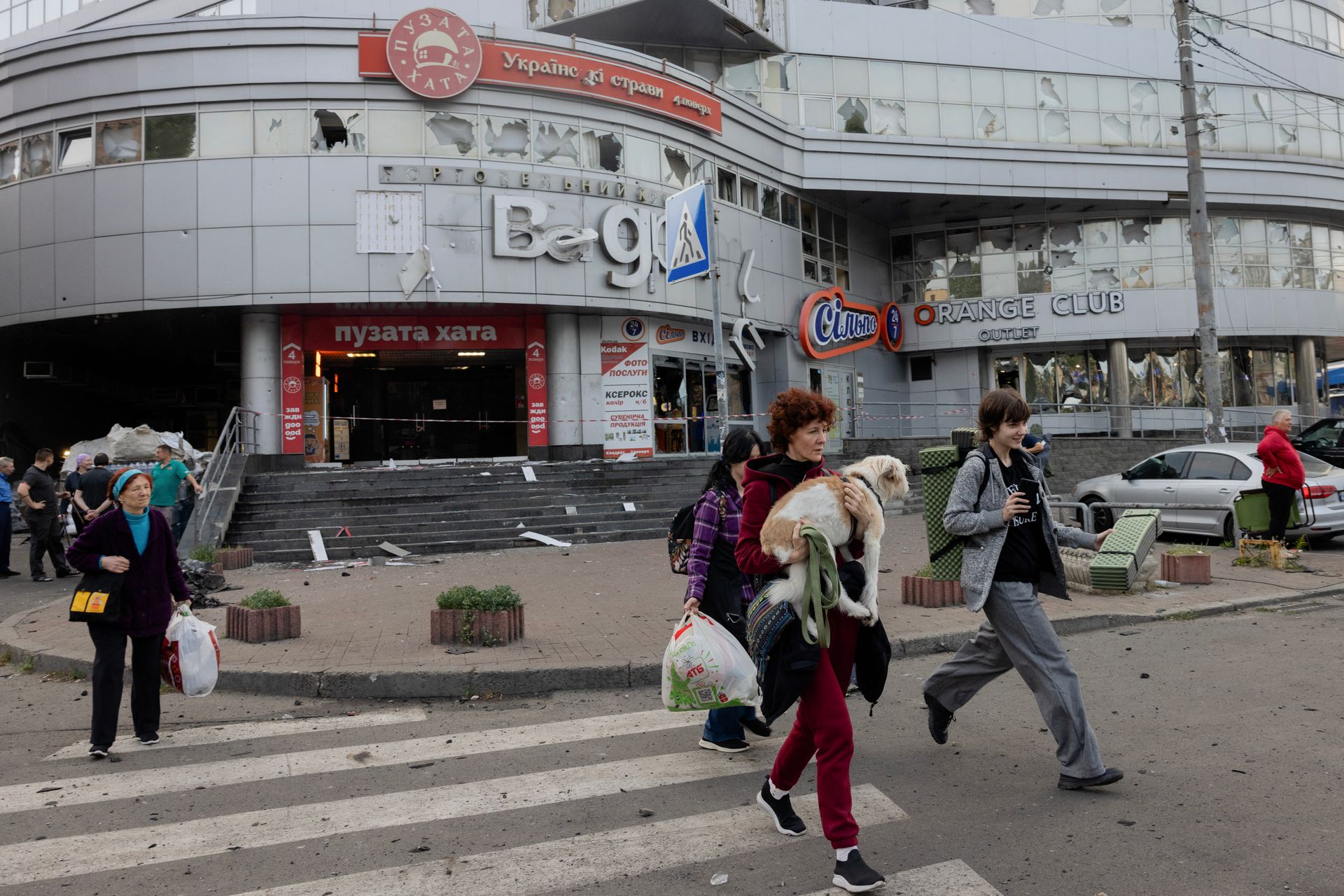 People leave a shelter with their belongings after a night of Russian strikes in Kyiv on July 10, 2025. (Tetiana Dzhafarova/AFP via Getty Images)
People leave a shelter with their belongings after a night of Russian strikes in Kyiv on July 10, 2025. (Tetiana Dzhafarova/AFP via Getty Images)
In the Podilskyi district, a primary healthcare center "was almost completely destroyed" in the Russian attack, Klitchsko later reported.
The attack damaged the studio of the Kanal 5 television channel, owned by former President Petro Poroshenko. While no employees were injured, filming equipment sustained damage, causing a temporary disruption to broadcasting.
It remains unclear whether Russia targeted or hit any military or other strategic targets in the attack, as Ukrainian authorities largely do not disclose such information for security reasons. This makes the full extent of casualties and damage impossible to verify.
Russian forces launched 397 drones against Ukraine overnight, with almost 200 of them being Shahed-type kamikaze drones and the rest decoys used to overwhelm Ukrainian air defenses, according to the Air Force.
Russia also fired eight Iskander-M ballistic missiles, six Kh-101 cruise missiles, and four S-300 guided air defense missiles, targeting primarily Kyiv, the statement read.
Ukrainian air defenses shot down 164 Shahed-type drones, eight Iskander-M missiles, and six Kh-101 missiles. Some 204 drones and missiles reportedly disappeared from radars or were intercepted by electronic warfare.
Zelensky urges 'Marshall Plan-style' support for Ukraine at Recovery Conference in Rome
President Volodymyr Zelensky called for a Marshall Plan-style reconstruction strategy to help Ukraine recover from Russia's all-out war in his opening remarks at the Ukraine Recovery Conference in Rome on July 10.
Earlier in the day, the president and First Lady Olena Zelenska arrived at the two-day event focused on mobilizing political and private-sector support for Ukraine's reconstruction. The previous three conferences have taken place in Lugano, London, and Berlin.
"We need a Marshall Plan-style approach, and we should develop it together," Zelensky told representatives of governments, international organizations, and businesses who gathered in Rome.
The Marshall Plan was an economic aid program that the United States offered to European countries after World War II to help them rebuild their economies.
"Rebuilding Ukraine is not just about our country. It's also about your countries, your companies, your technology, your jobs," Zelensky said.
Drawing comparisons to existing international coalitions supporting Kyiv's military efforts, he called upon international partners to form a recovery coalition and help Ukraine rebuild with a systematic approach.
"The way we rebuild our country can also modernize your infrastructure and industries. And I ask you to support the recovery coalition and help define specific financing mechanisms."
Zelensky stressed that Kyiv would welcome only "true partners" in the initiative, "those who are not helping Russia continue this war."
Note from the author:
Ukraine War Latest is put together by the Kyiv Independent news desk team, who keep you informed 24 hours a day, seven days a week. If you value our work and want to ensure we have the resources to continue, join the Kyiv Independent community.
From The Kyiv Independent - News from Ukraine, Eastern Europe via this RSS feed
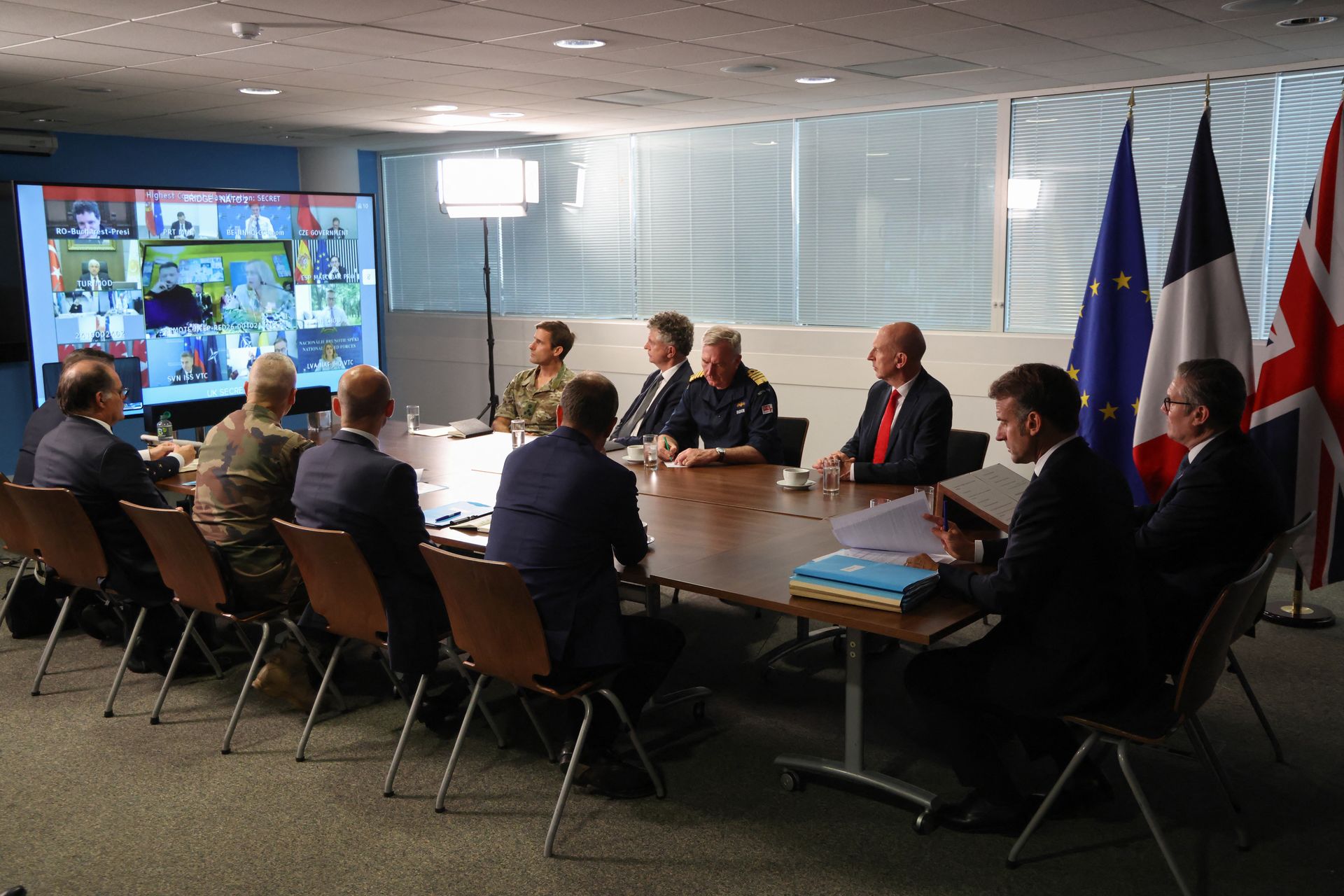 U.K. Prime Minister Keir Starmer and French President Emmanuel Macron host a meeting of the "coalition of the willing" during a joint military visit to the Northwood Headquarters in London, England, on July 10, 2025. (Ludovic Marin/Pool/AFP via Getty Images)
U.K. Prime Minister Keir Starmer and French President Emmanuel Macron host a meeting of the "coalition of the willing" during a joint military visit to the Northwood Headquarters in London, England, on July 10, 2025. (Ludovic Marin/Pool/AFP via Getty Images)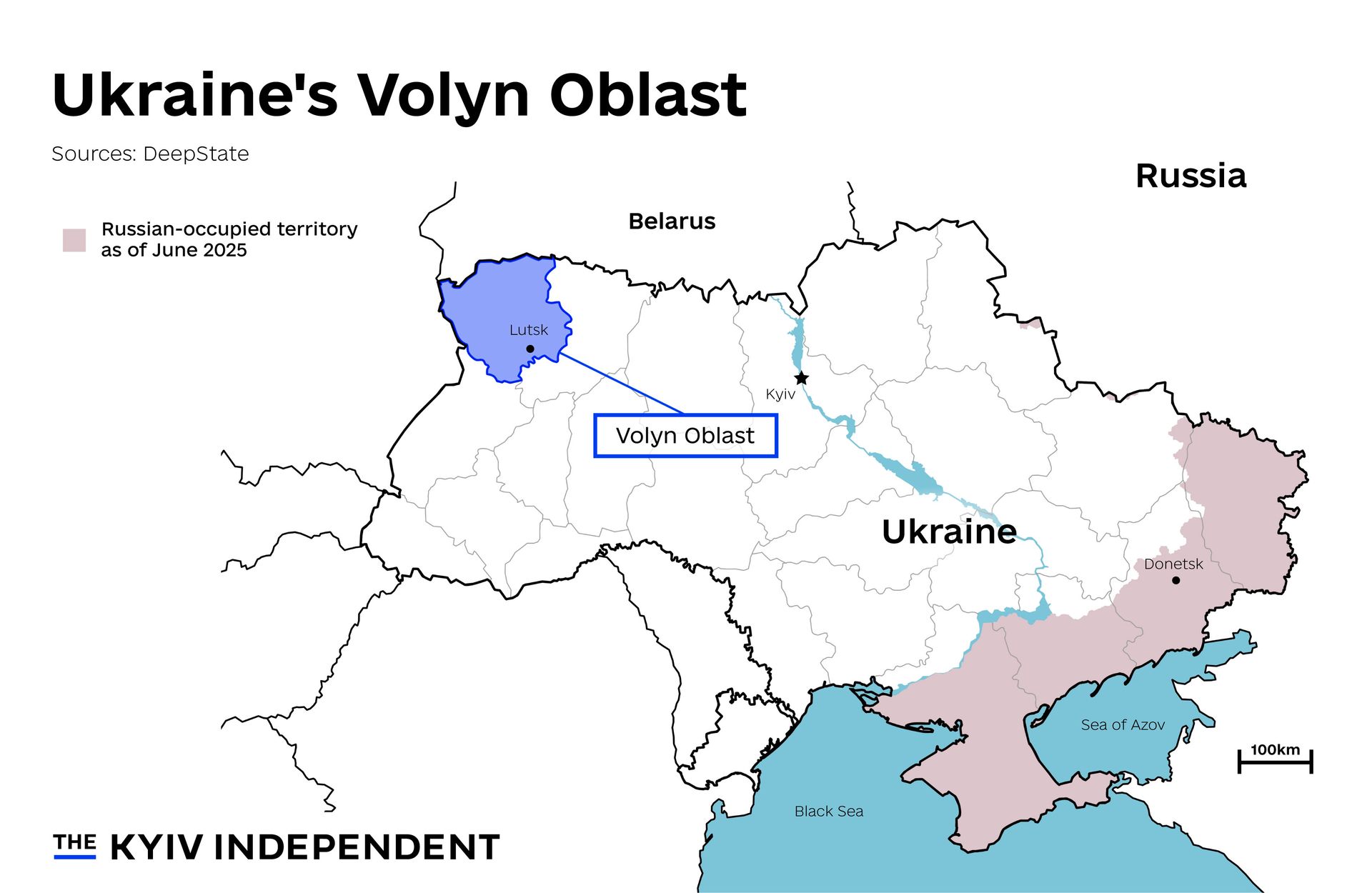 Ukraine's Volyn Oblast (Nizar al-Rifai/The Kyiv Independent)
Ukraine's Volyn Oblast (Nizar al-Rifai/The Kyiv Independent)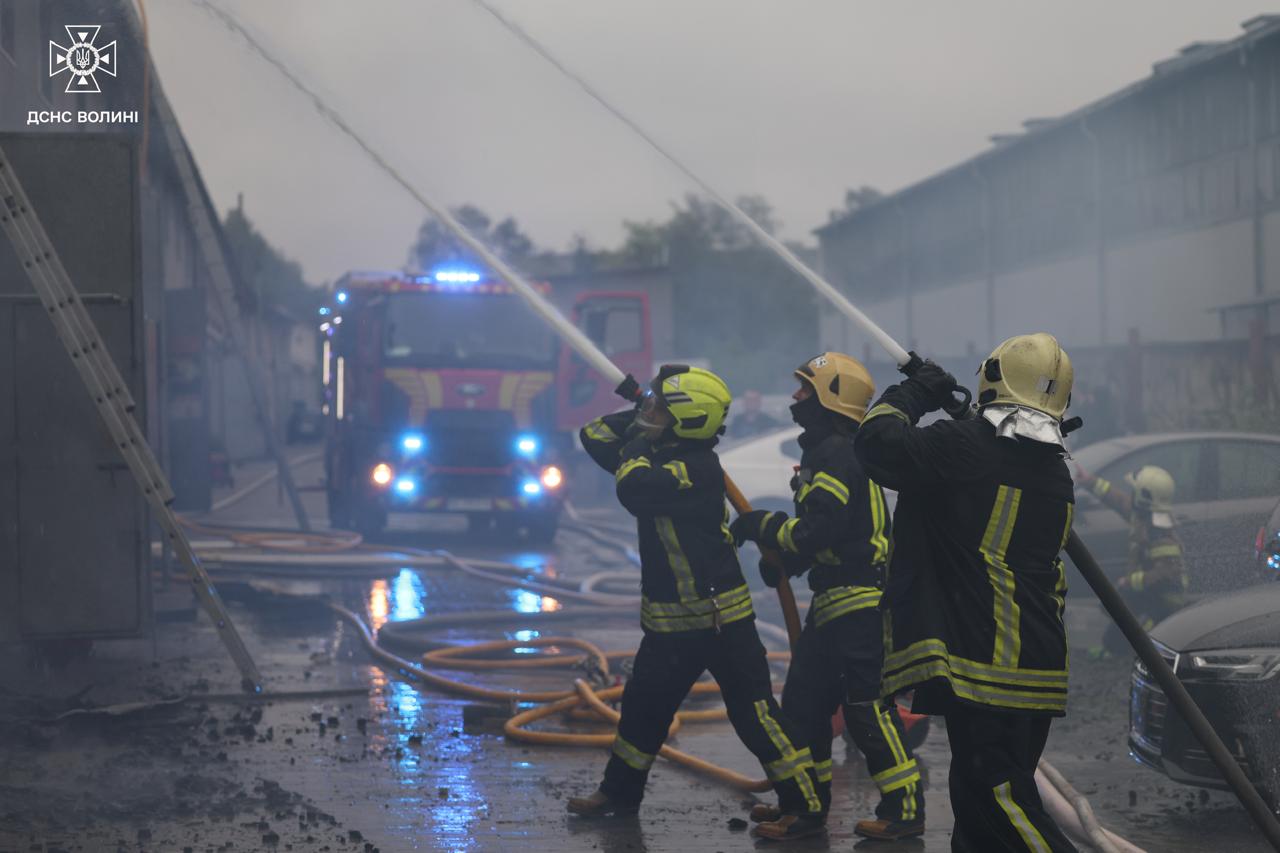
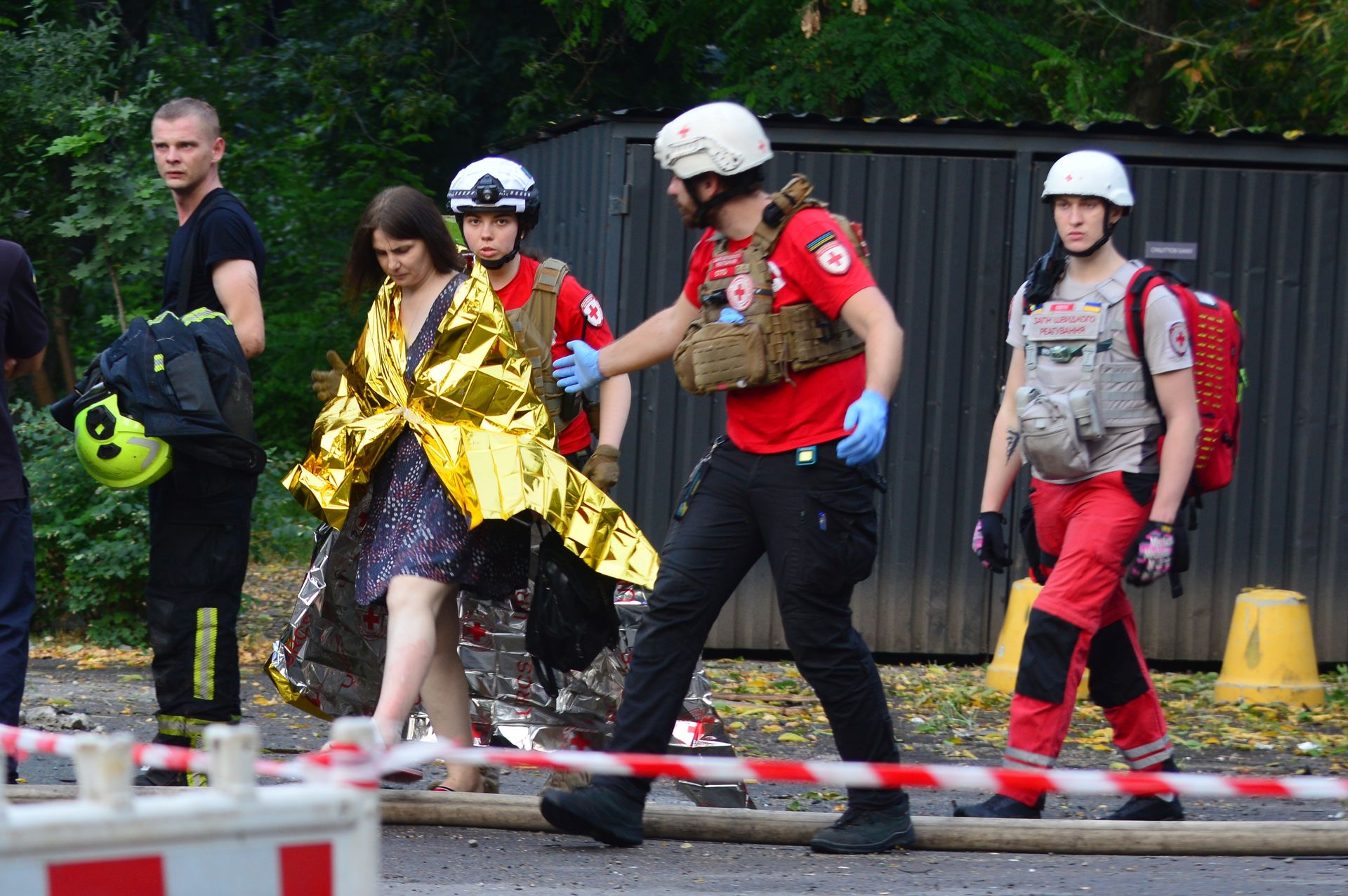 Red Cross medics evacuate a woman from a damaged residential building after a Russian drones and missiles attack on July 10, 2025 in Kyiv, Ukraine (Oleksandr Gusev/Global Images Ukraine via Getty Images)
Red Cross medics evacuate a woman from a damaged residential building after a Russian drones and missiles attack on July 10, 2025 in Kyiv, Ukraine (Oleksandr Gusev/Global Images Ukraine via Getty Images)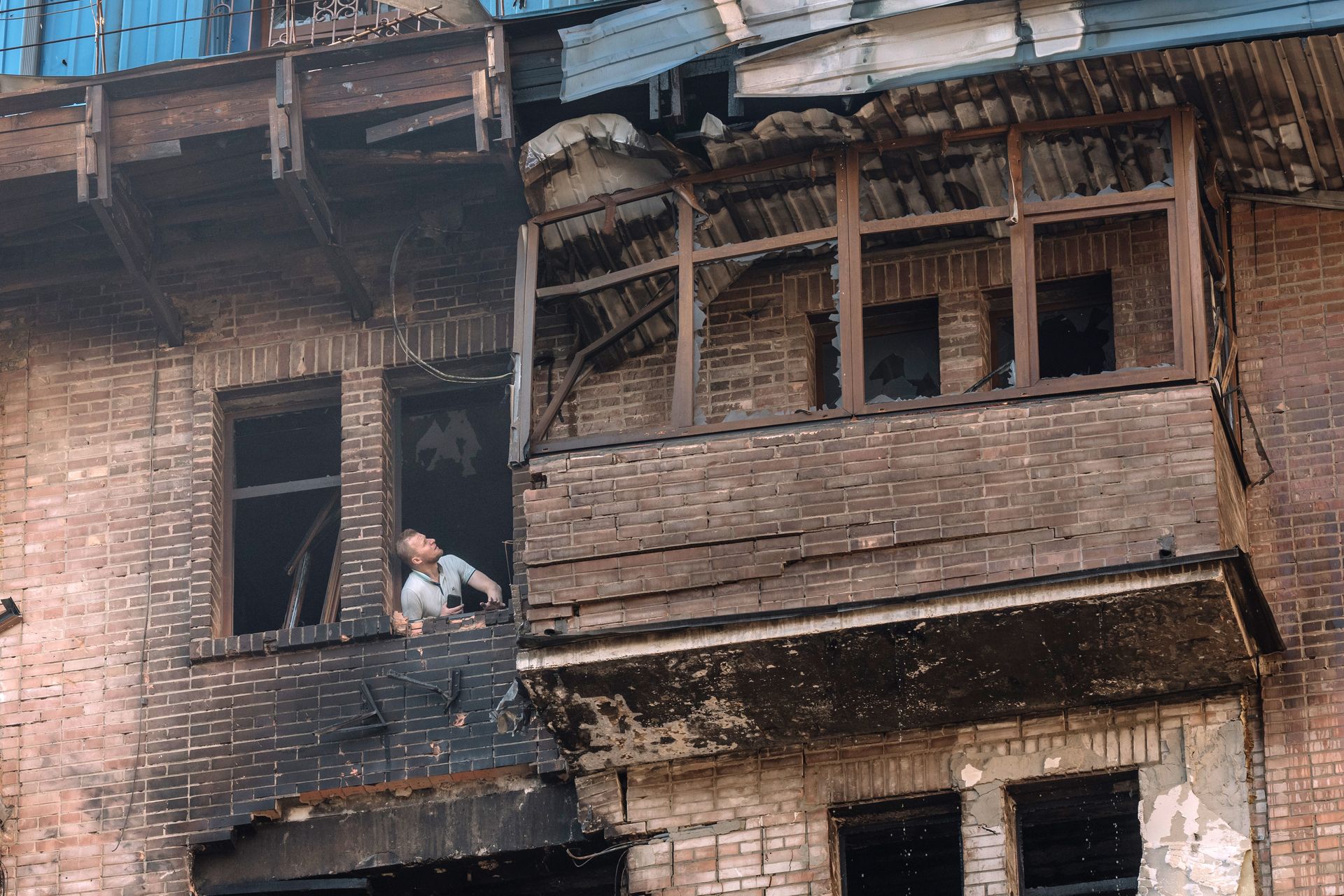 A resident looks at the damage to apartments following Russian air strikes in Kyiv, Ukraine, on Thursday, July 10, 2025 (Andrew Kravchenko/Bloomberg via Getty Images)
A resident looks at the damage to apartments following Russian air strikes in Kyiv, Ukraine, on Thursday, July 10, 2025 (Andrew Kravchenko/Bloomberg via Getty Images)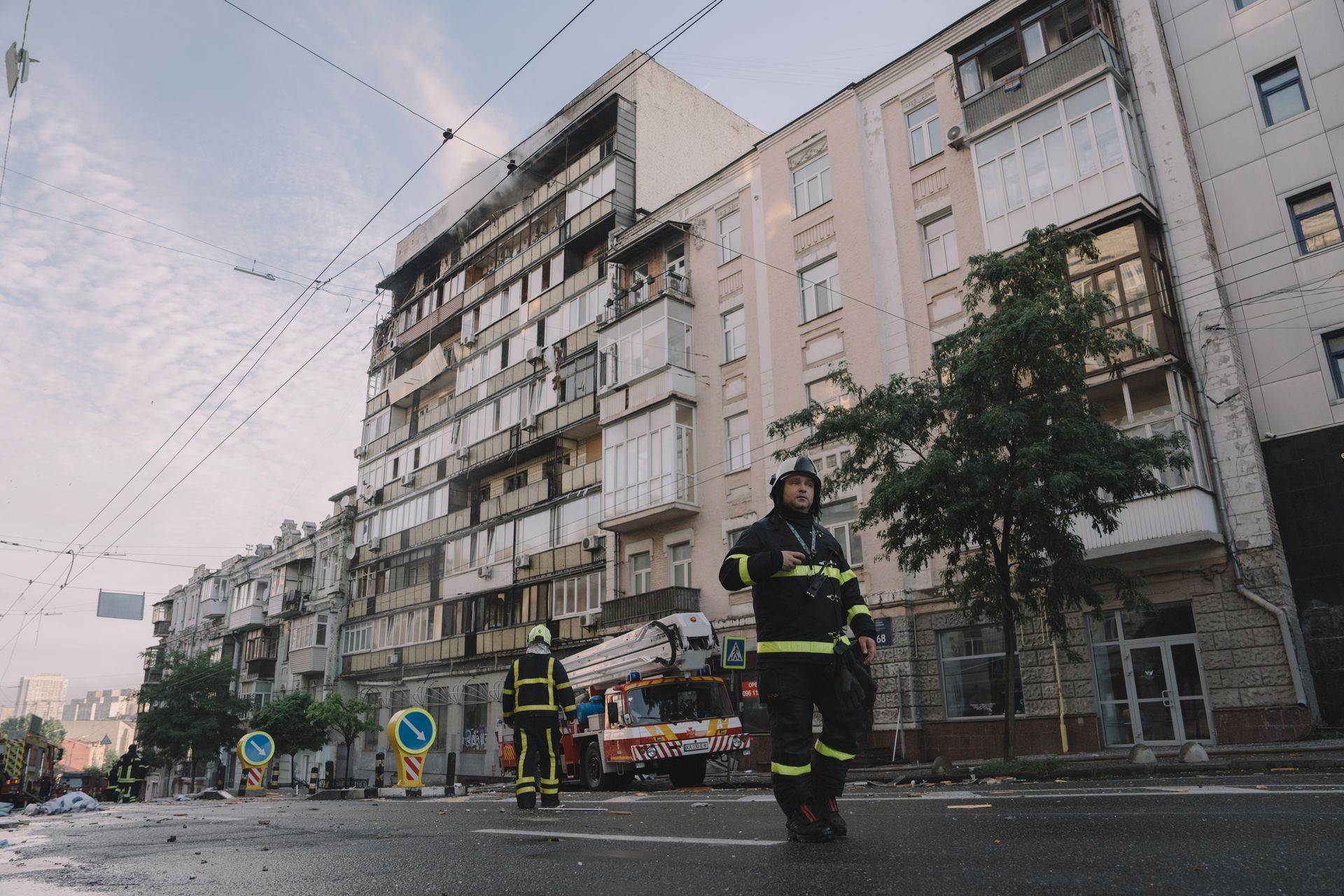 Emergency service workers at the site of a Russian air strike which hit a residential building in Kyiv, Ukraine, on Thursday, July 10, 2025 (Andrew Kravchenko/Bloomberg via Getty Images)
Emergency service workers at the site of a Russian air strike which hit a residential building in Kyiv, Ukraine, on Thursday, July 10, 2025 (Andrew Kravchenko/Bloomberg via Getty Images)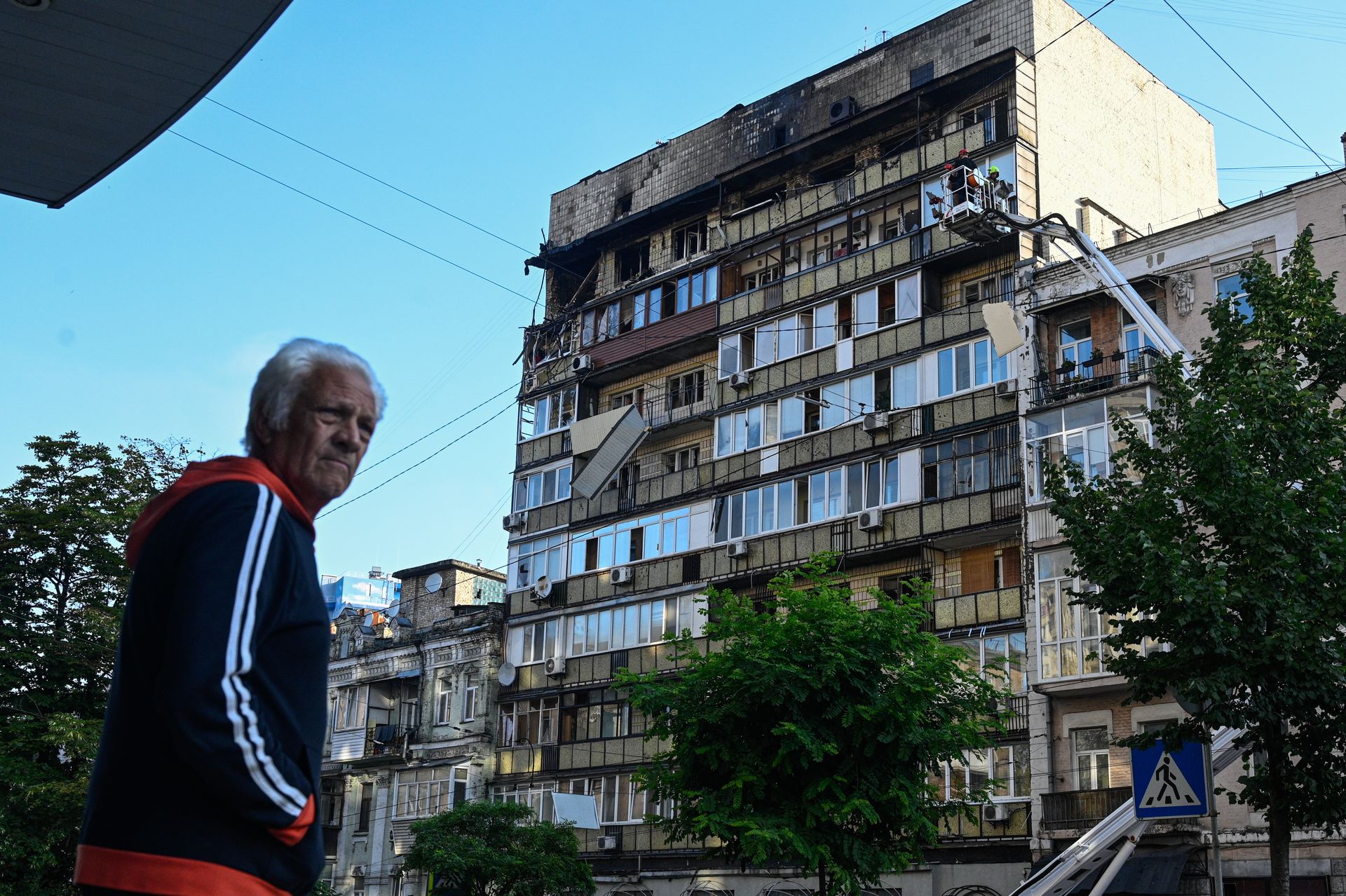 A local resident reacts at the site of a Russian attack that damaged a resident building in Kyiv, Ukraine on July 10, 2025 (Danylo Antoniuk/Anadolu via Getty Images)
A local resident reacts at the site of a Russian attack that damaged a resident building in Kyiv, Ukraine on July 10, 2025 (Danylo Antoniuk/Anadolu via Getty Images)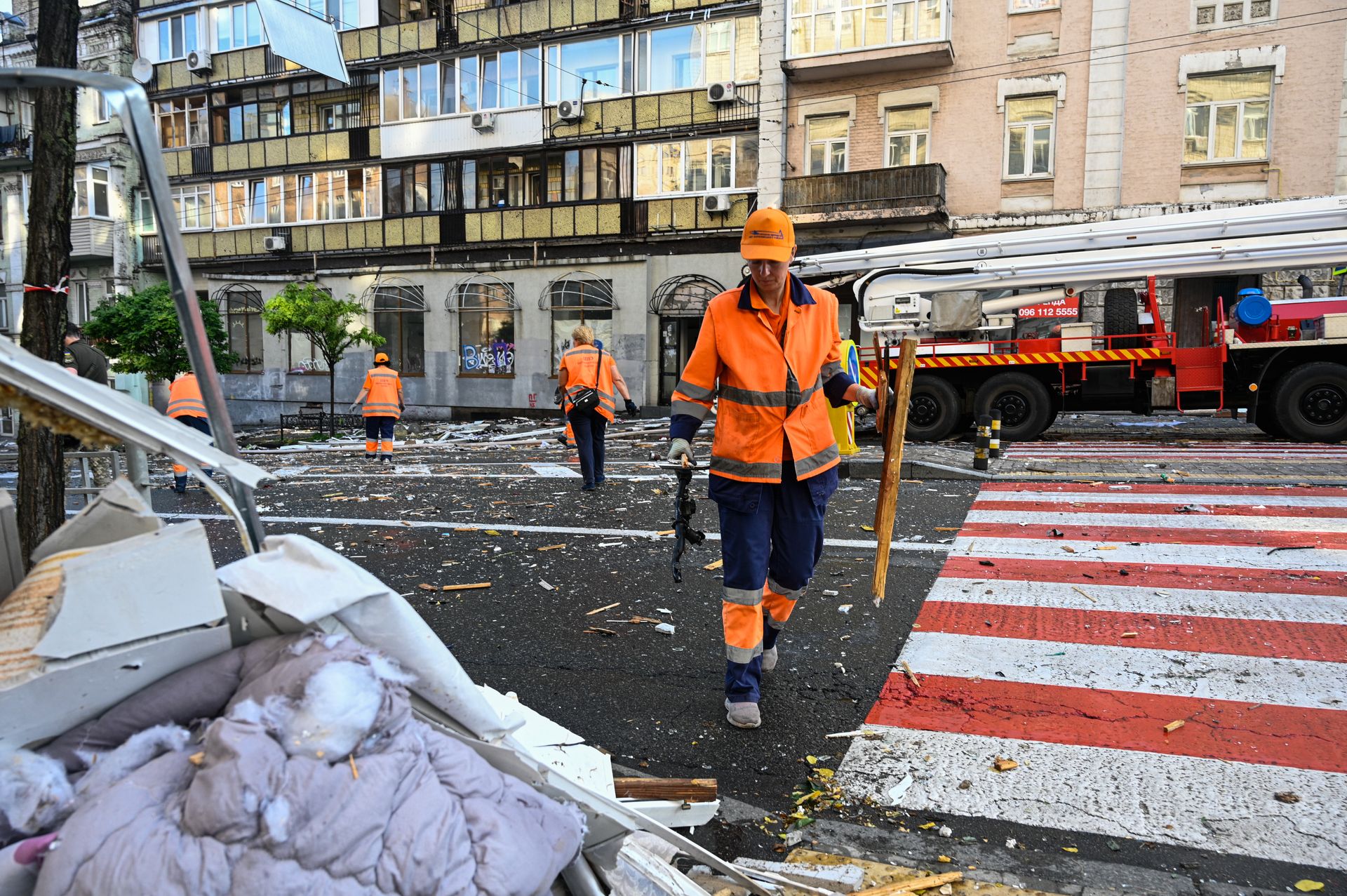 A communal worker is seen working at the site of a Russian attack that damaged a resident building in Kyiv, Ukraine on July 10, 2025 (Danylo Antoniuk/Anadolu via Getty Images)
A communal worker is seen working at the site of a Russian attack that damaged a resident building in Kyiv, Ukraine on July 10, 2025 (Danylo Antoniuk/Anadolu via Getty Images)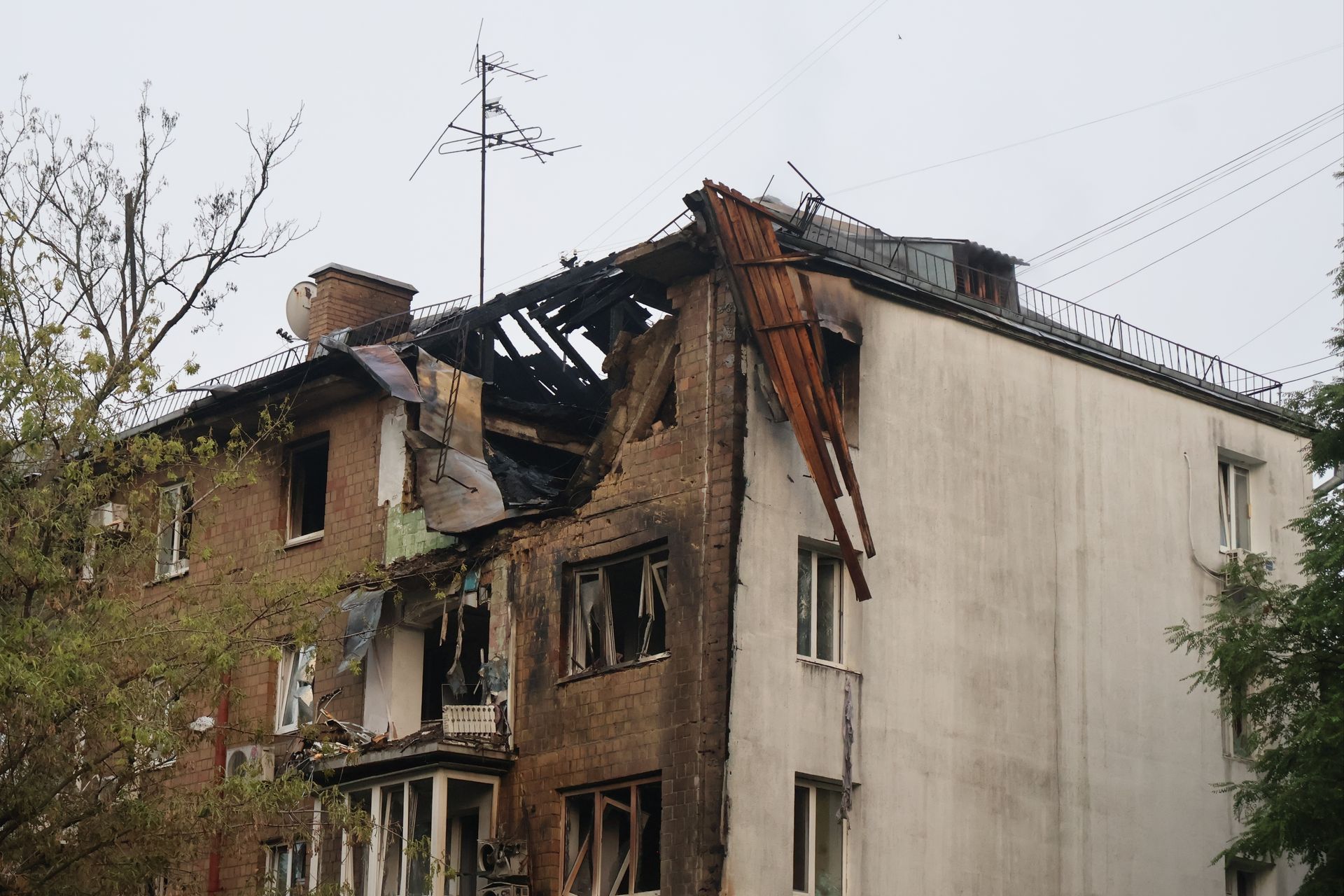 A view of a damaged residential building after a Russian drones and missiles attack on July 10, 2025 in Kyiv, Ukraine (Oleksandr Gusev/Global Images Ukraine via Getty Images)
A view of a damaged residential building after a Russian drones and missiles attack on July 10, 2025 in Kyiv, Ukraine (Oleksandr Gusev/Global Images Ukraine via Getty Images)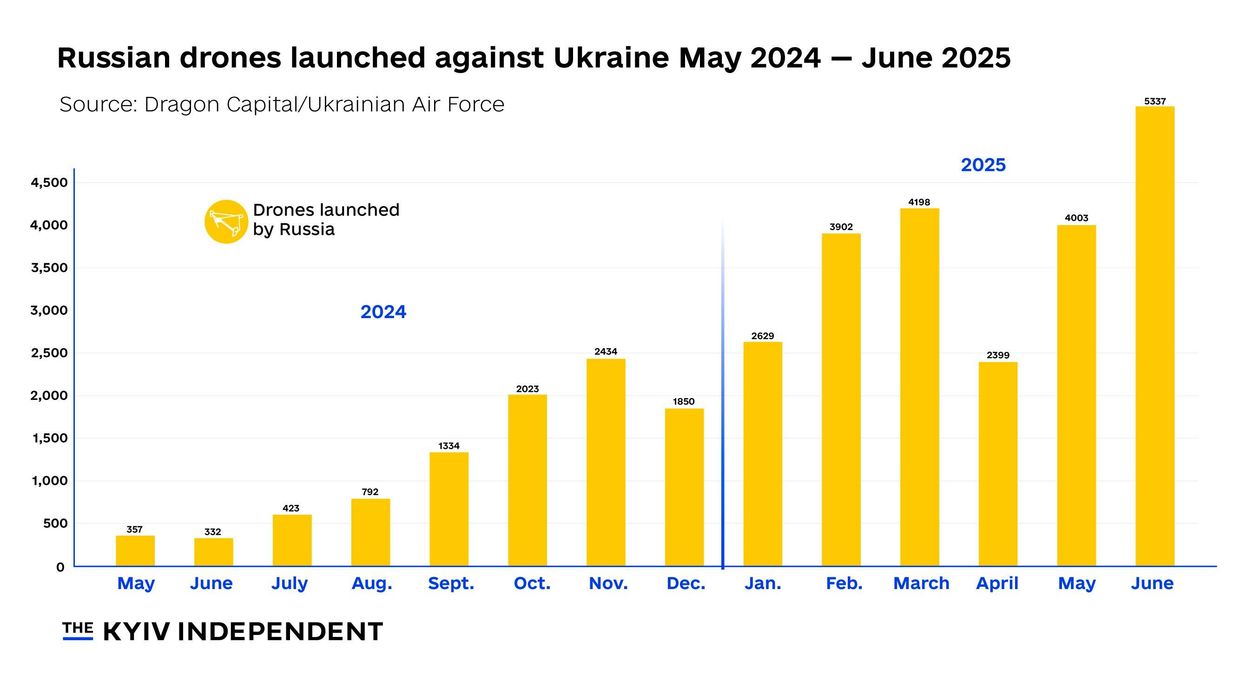 Russian drones launched against Ukraine by month. (Nizar al-Rifai/The Kyiv Independent)
Russian drones launched against Ukraine by month. (Nizar al-Rifai/The Kyiv Independent)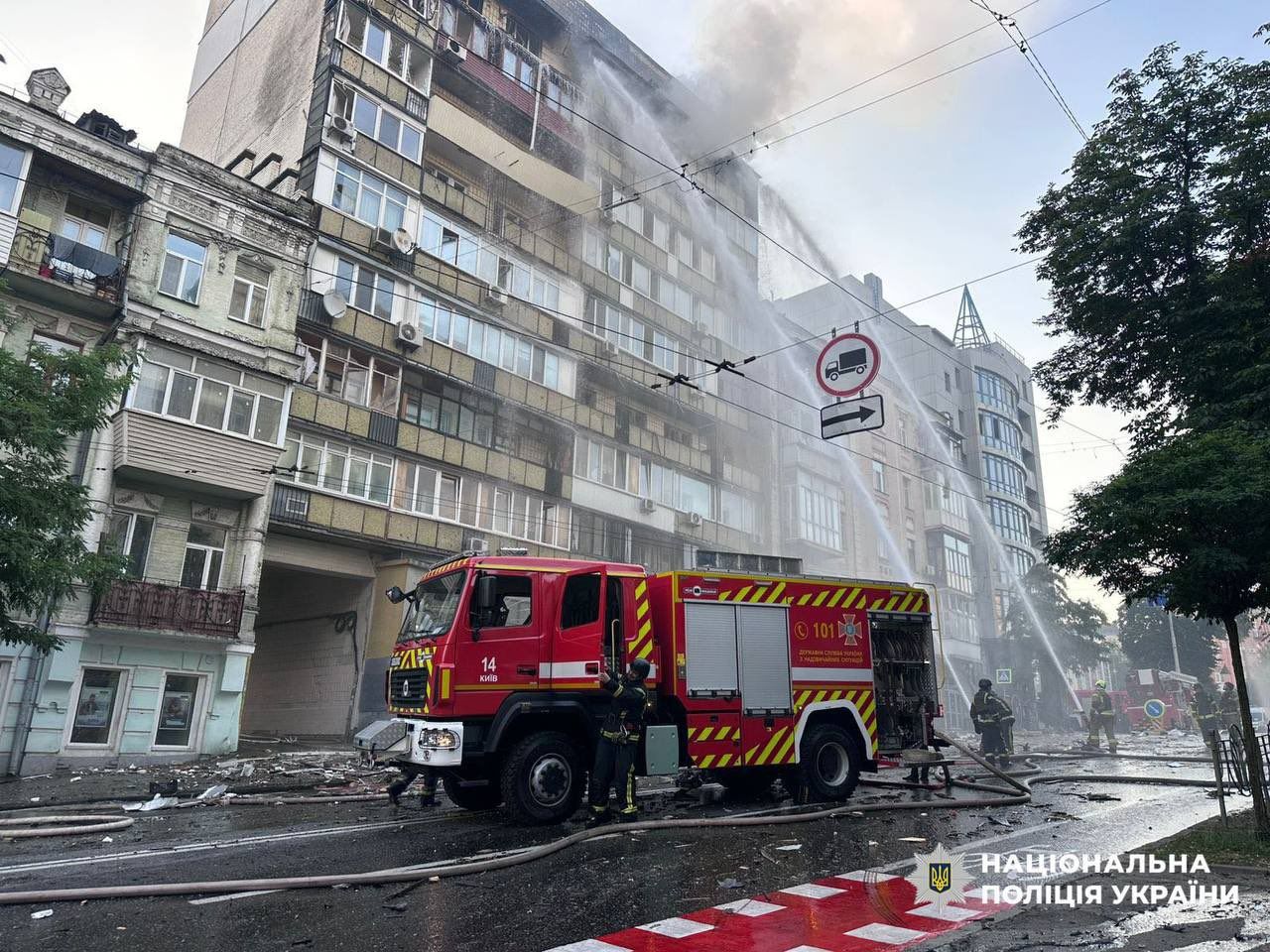 Firemen work to put out a blaze after a mass aerial attack on Kyiv on July 10, 2025. (Andrii Sybiha / X)
Firemen work to put out a blaze after a mass aerial attack on Kyiv on July 10, 2025. (Andrii Sybiha / X)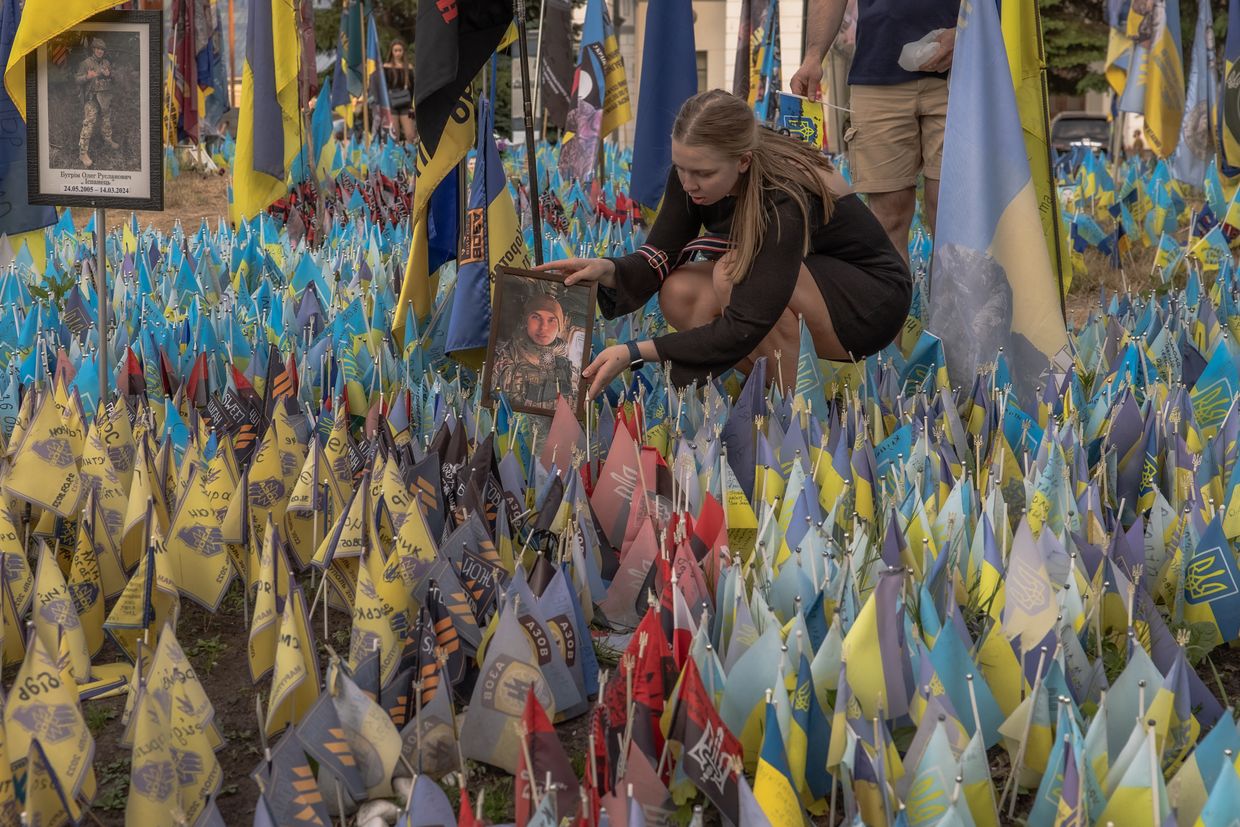 A woman displays a portrait of a Ukrainian army serviceman at a memorial at Independence Square, commemorating Ukrainian and foreign fighters, as well as civilians, killed during the Russian invasion of Ukraine, in Kyiv, on May 27, 2024. (Roman Pilipey / AFP via Getty Images)
A woman displays a portrait of a Ukrainian army serviceman at a memorial at Independence Square, commemorating Ukrainian and foreign fighters, as well as civilians, killed during the Russian invasion of Ukraine, in Kyiv, on May 27, 2024. (Roman Pilipey / AFP via Getty Images)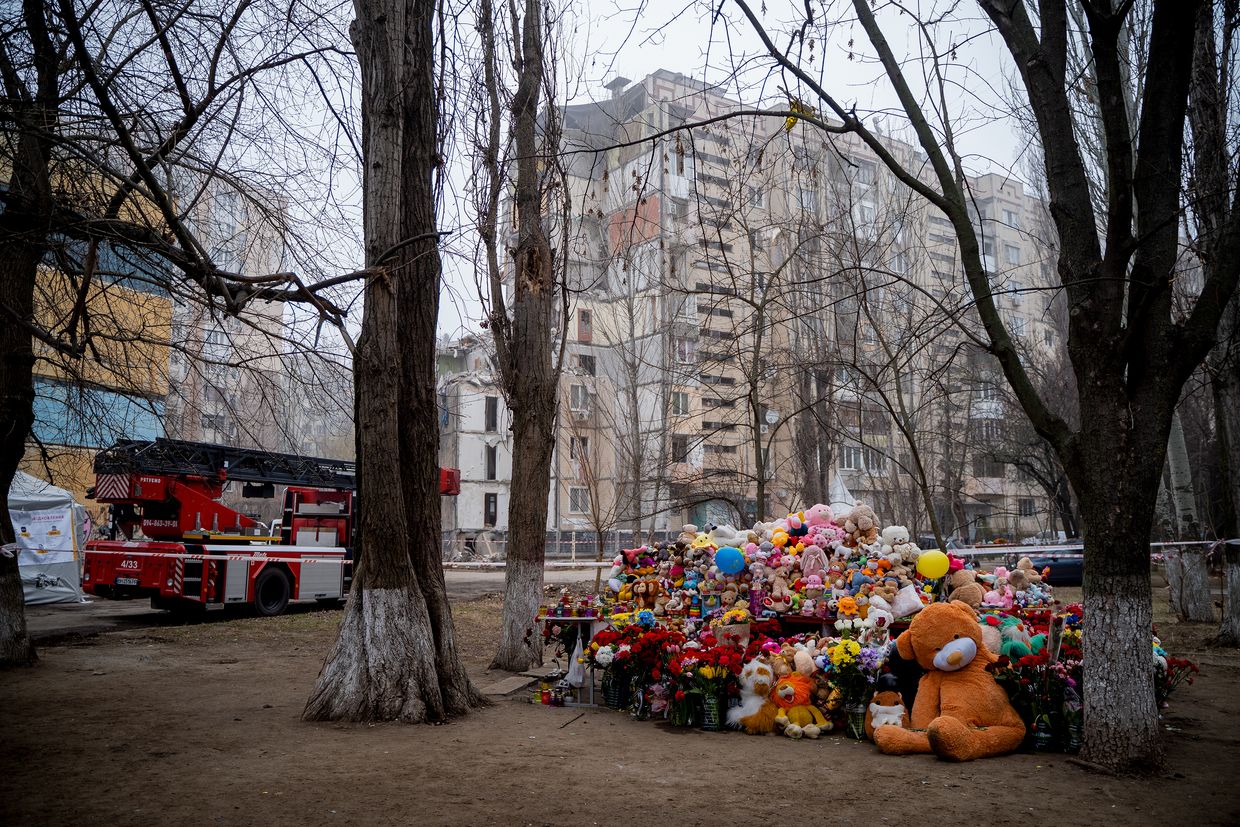 An improvised memorial in honor of the children who died as a result of the Russian drone attack is displayed on March 5, 2024 in Odesa, Ukraine. (Tanya Dzafarowa/Suspilne Ukraine/JSC "UA:PBC"/Global Images Ukraine via Getty Images)
An improvised memorial in honor of the children who died as a result of the Russian drone attack is displayed on March 5, 2024 in Odesa, Ukraine. (Tanya Dzafarowa/Suspilne Ukraine/JSC "UA:PBC"/Global Images Ukraine via Getty Images) A U.S. Army Reserve soldier reads some of the 58,272 names etched into "The Wall" of the Vietnam Veterans Memorial in Washington as the sun rises on July 22, 2015. (Sgt. Ken Scar via the U.S. Department of Defense)
A U.S. Army Reserve soldier reads some of the 58,272 names etched into "The Wall" of the Vietnam Veterans Memorial in Washington as the sun rises on July 22, 2015. (Sgt. Ken Scar via the U.S. Department of Defense)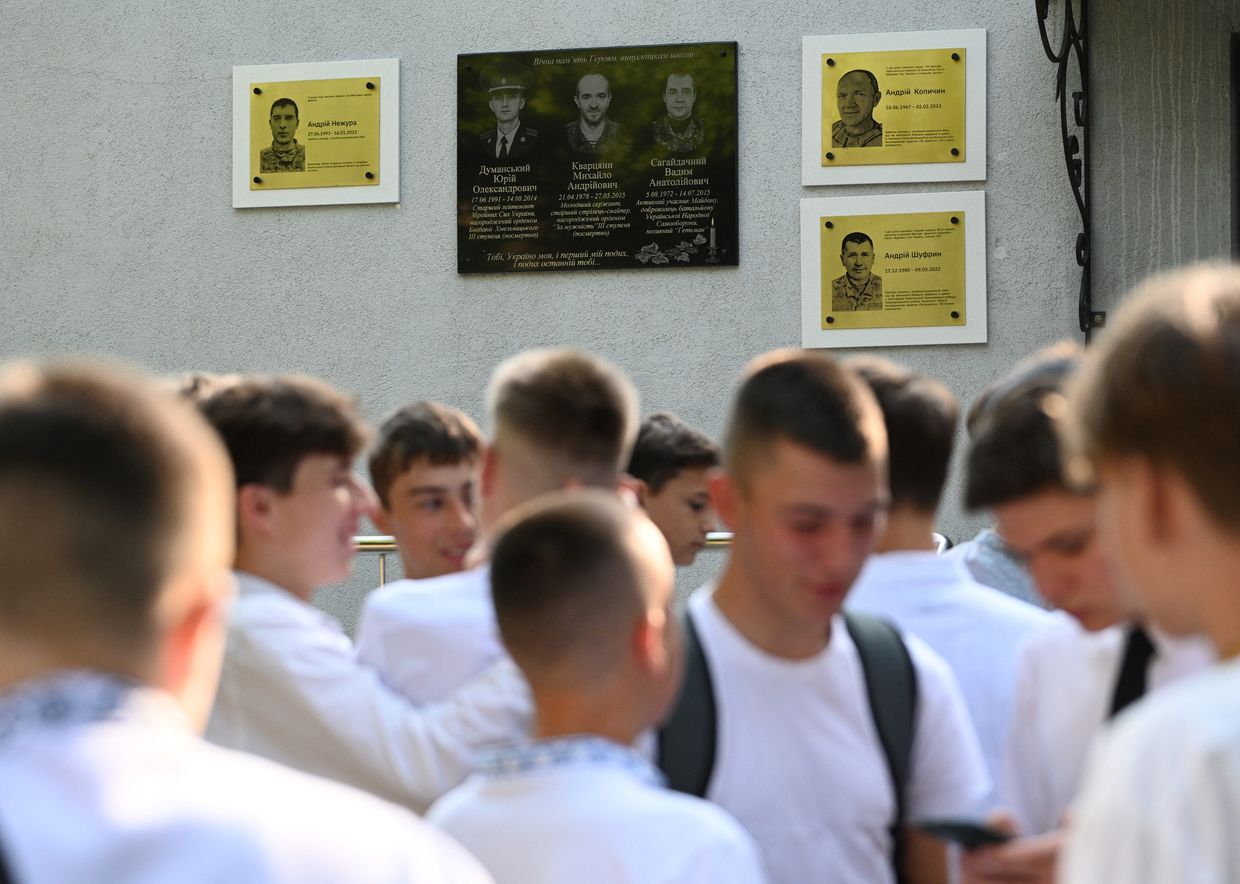 Children stand in front of memorial plaques for those killed by the Russian war on the first day of the new school year in Lviv on Sept.2, 2024. (Yuriy Dyachyshyn/AFP via Getty Images)
Children stand in front of memorial plaques for those killed by the Russian war on the first day of the new school year in Lviv on Sept.2, 2024. (Yuriy Dyachyshyn/AFP via Getty Images)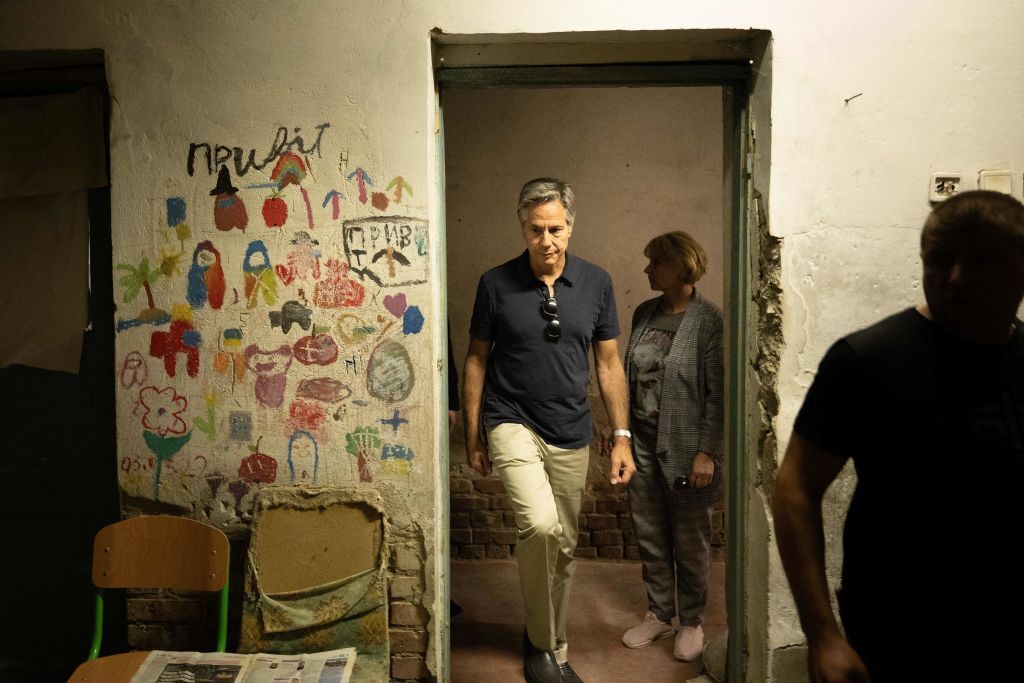 U.S. Secretary of State Antony Blinken enters the basement of the school in Yahidne on Sept. 7, 2023. (Brendan Smialowski/AFP via Getty Images)
U.S. Secretary of State Antony Blinken enters the basement of the school in Yahidne on Sept. 7, 2023. (Brendan Smialowski/AFP via Getty Images)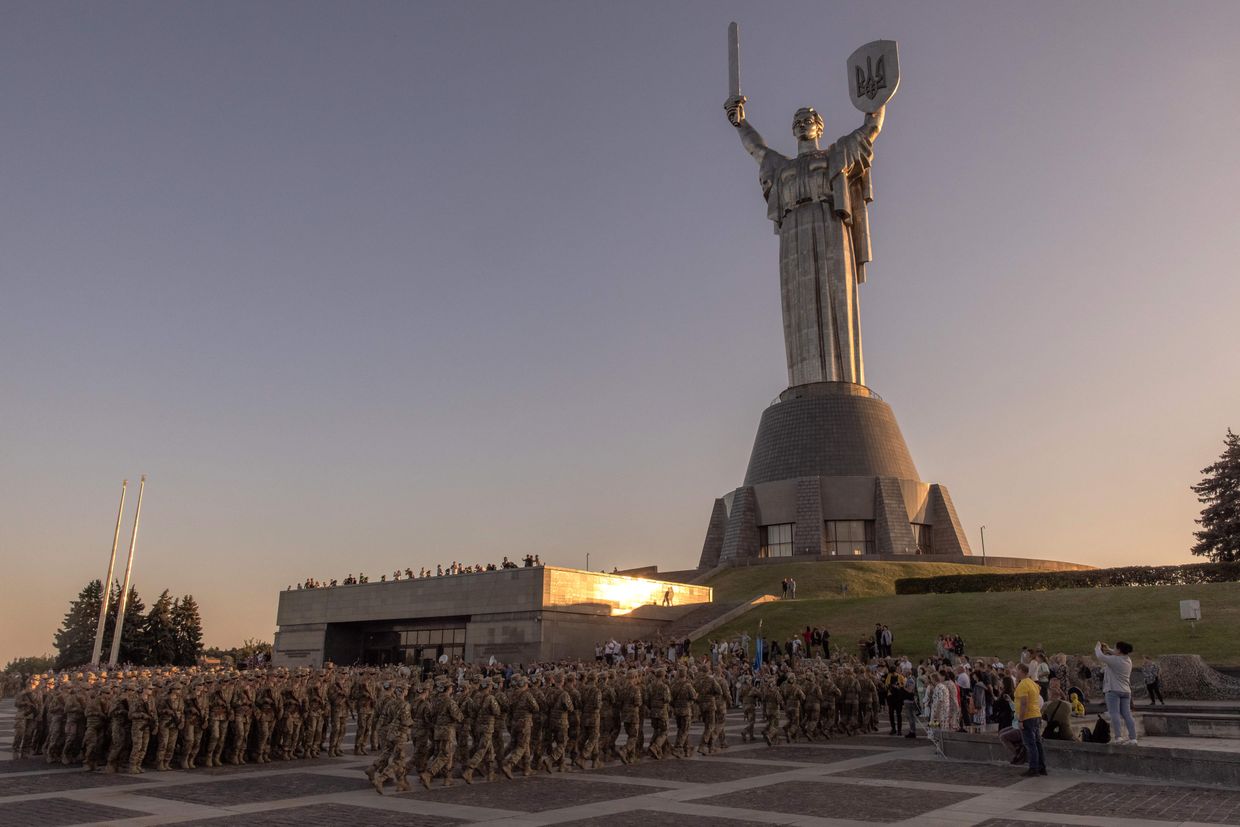 Ukrainian cadets attend a ceremony at the National Museum of the History of Ukraine in the Second World War, in Kyiv, on Sept. 8, 2023, amid the Russian invasion of Ukraine. The Soviet coat of arms on the Motherland Monument's shield was replaced with a Ukrainian trident in 2023. (Roman Pilipey/AFP via Getty Images)
Ukrainian cadets attend a ceremony at the National Museum of the History of Ukraine in the Second World War, in Kyiv, on Sept. 8, 2023, amid the Russian invasion of Ukraine. The Soviet coat of arms on the Motherland Monument's shield was replaced with a Ukrainian trident in 2023. (Roman Pilipey/AFP via Getty Images)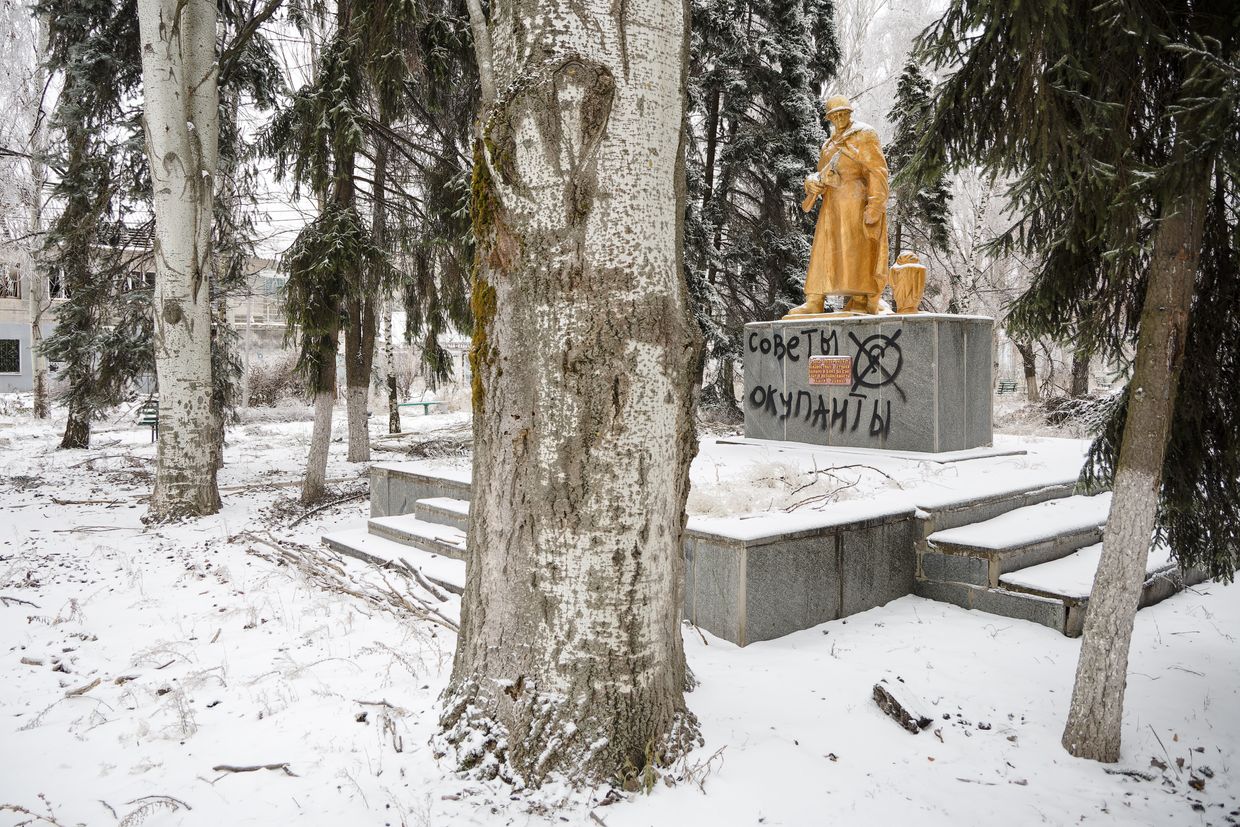 The inscription "Soviet occupiers" is seen on a World War II memorial in Chasiv Yar, Donetsk Oblast, on Dec. 13, 2023. (Dmytro Larin/Global Images Ukraine via Getty Images)
The inscription "Soviet occupiers" is seen on a World War II memorial in Chasiv Yar, Donetsk Oblast, on Dec. 13, 2023. (Dmytro Larin/Global Images Ukraine via Getty Images)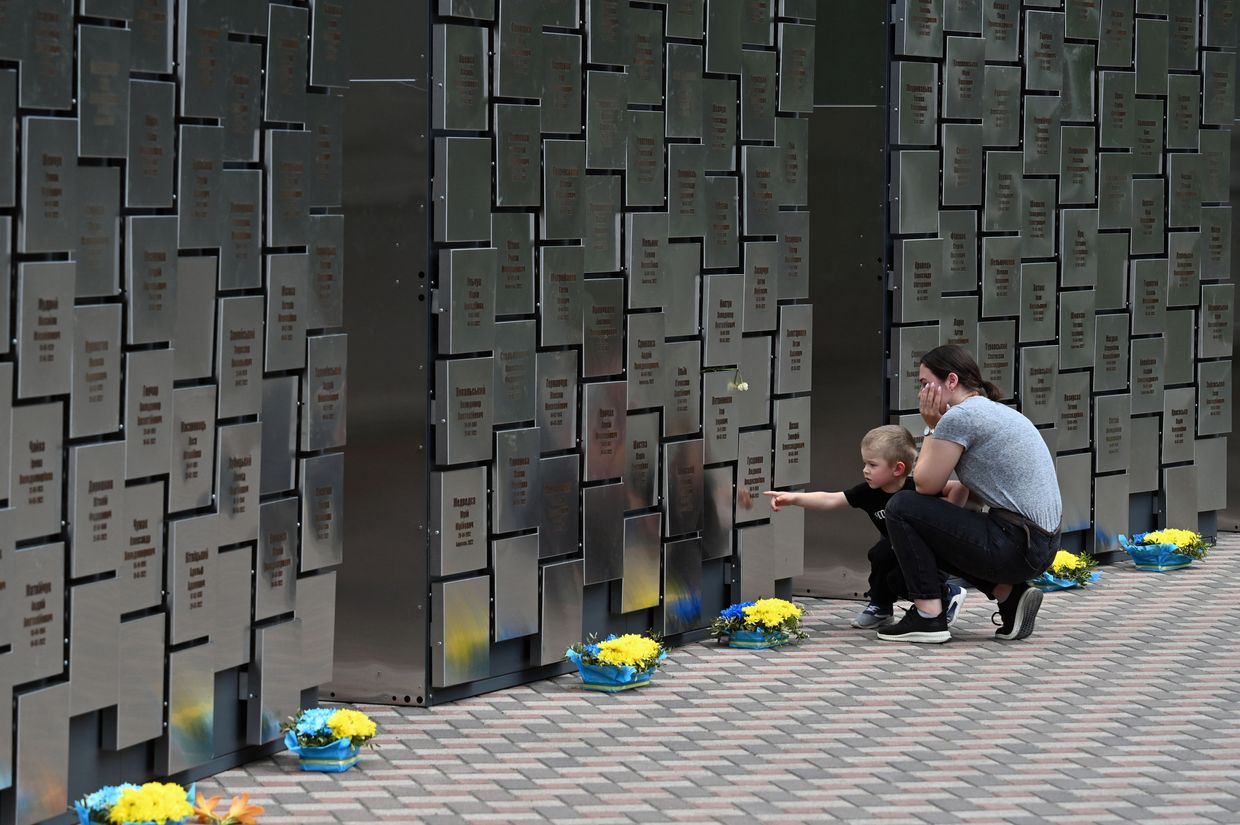 A young woman and her son stand in front of a recently inaugurated memorial, including 501 plates bearing the names of identified local civilians killed by Russian troops during their occupation of Bucha, north of Kyiv, on July 3, 2023. (Sergei Supinsky/AFP via Getty Images)
A young woman and her son stand in front of a recently inaugurated memorial, including 501 plates bearing the names of identified local civilians killed by Russian troops during their occupation of Bucha, north of Kyiv, on July 3, 2023. (Sergei Supinsky/AFP via Getty Images)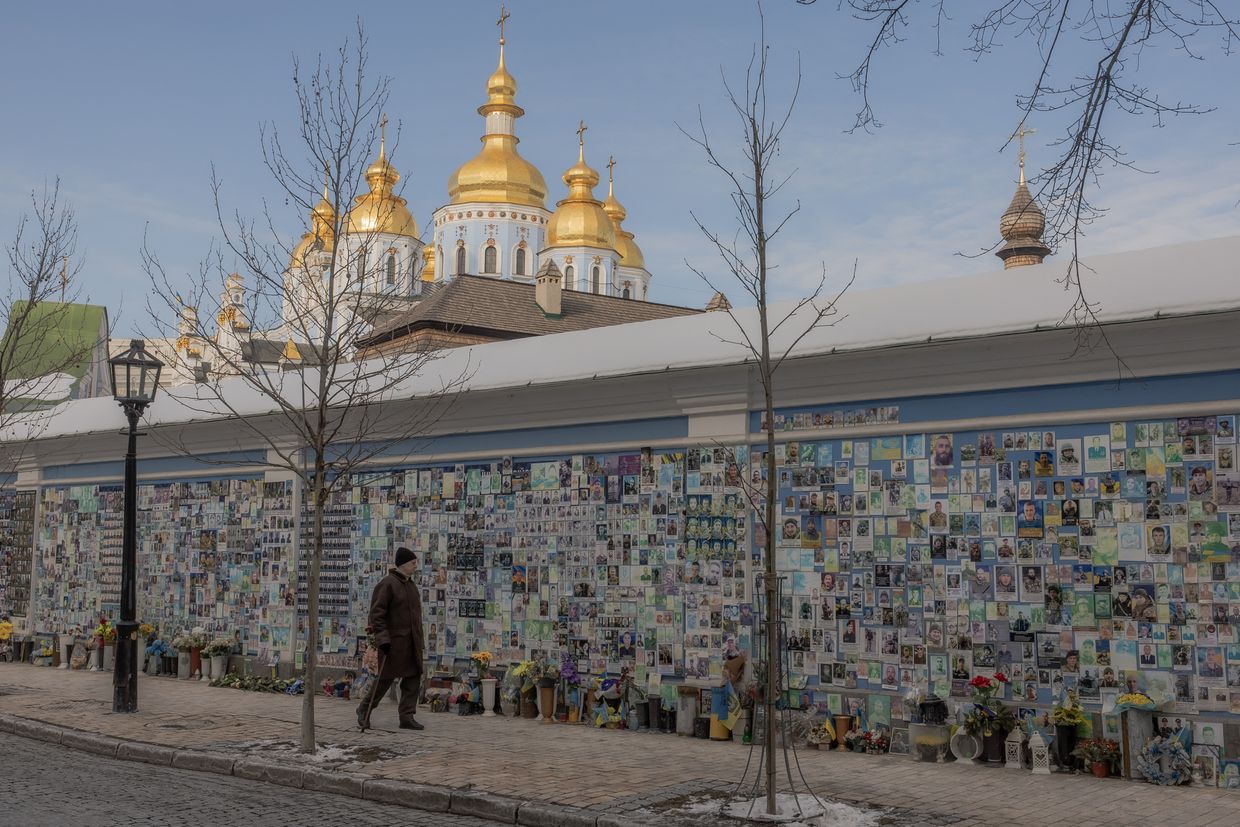 A pedestrian walks next to the "The Wall of Remembrance of the Fallen for Ukraine," a memorial for Ukrainian soldiers, in Kyiv, on Feb. 23, 2025, ahead of the third anniversary of Russia's invasion of Ukraine. (Roman Pilipey / AFP via Getty Images)
A pedestrian walks next to the "The Wall of Remembrance of the Fallen for Ukraine," a memorial for Ukrainian soldiers, in Kyiv, on Feb. 23, 2025, ahead of the third anniversary of Russia's invasion of Ukraine. (Roman Pilipey / AFP via Getty Images)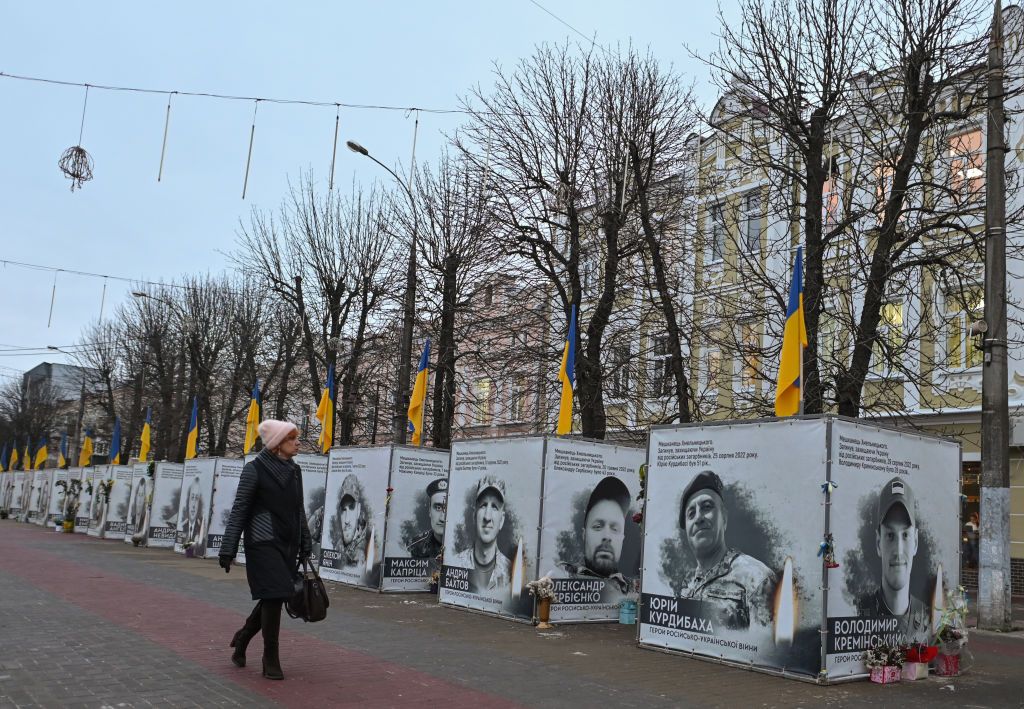 A woman walks past an open-air memorial located in the center of Khmelnytskyi, Ukraine on Dec. 20, 2022. (Artur Widak/NurPhoto via Getty Images)
A woman walks past an open-air memorial located in the center of Khmelnytskyi, Ukraine on Dec. 20, 2022. (Artur Widak/NurPhoto via Getty Images)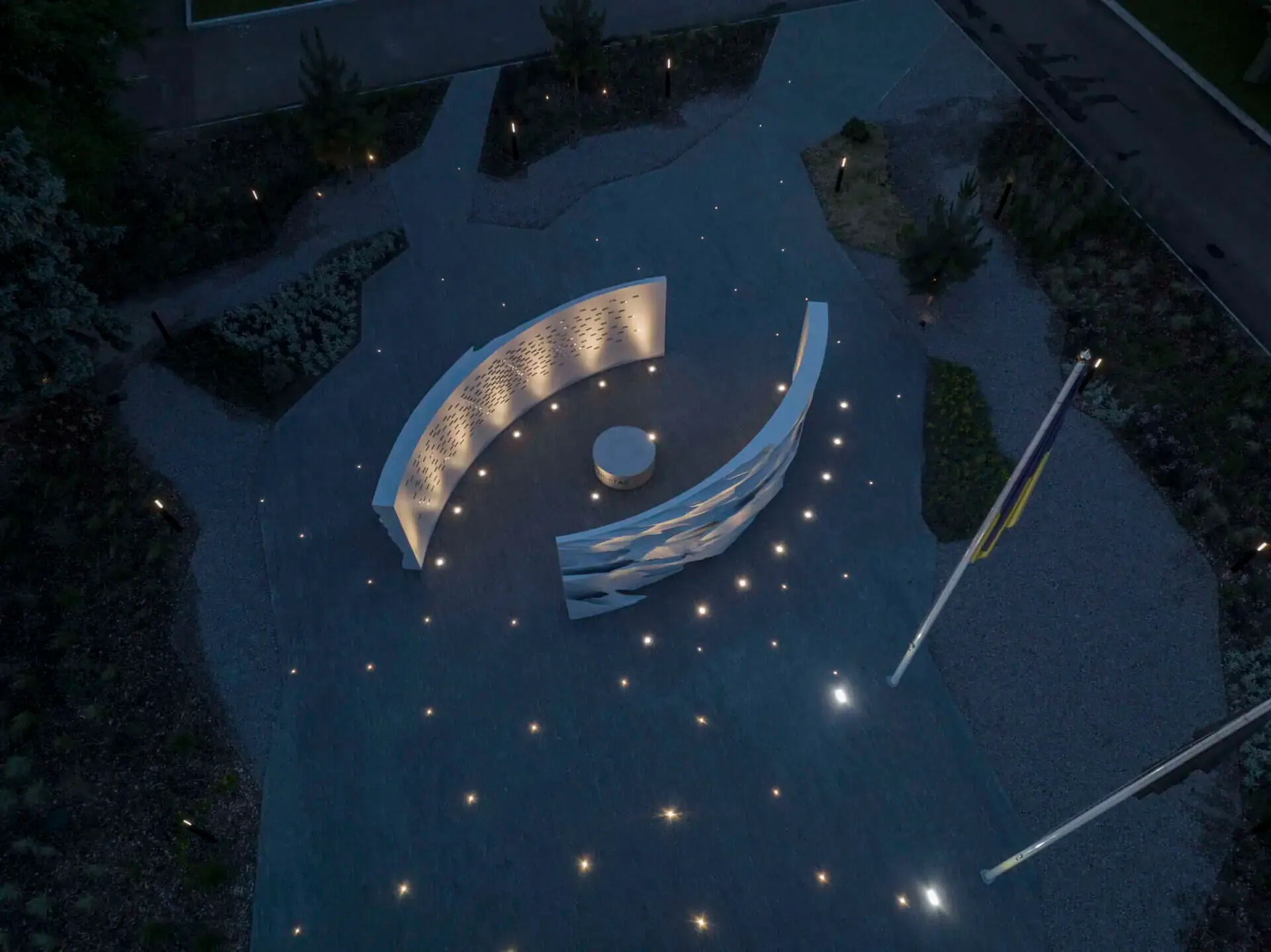 A view from above of the new memorial for Ukraine's military intelligence members, designed by Nazar Bilyk and built in the courtyard of the Main Intelligence Directorate (HUR) in Kyiv, in June, 2025. (Dmytro Kolos via Past / Future / Art platform)
A view from above of the new memorial for Ukraine's military intelligence members, designed by Nazar Bilyk and built in the courtyard of the Main Intelligence Directorate (HUR) in Kyiv, in June, 2025. (Dmytro Kolos via Past / Future / Art platform)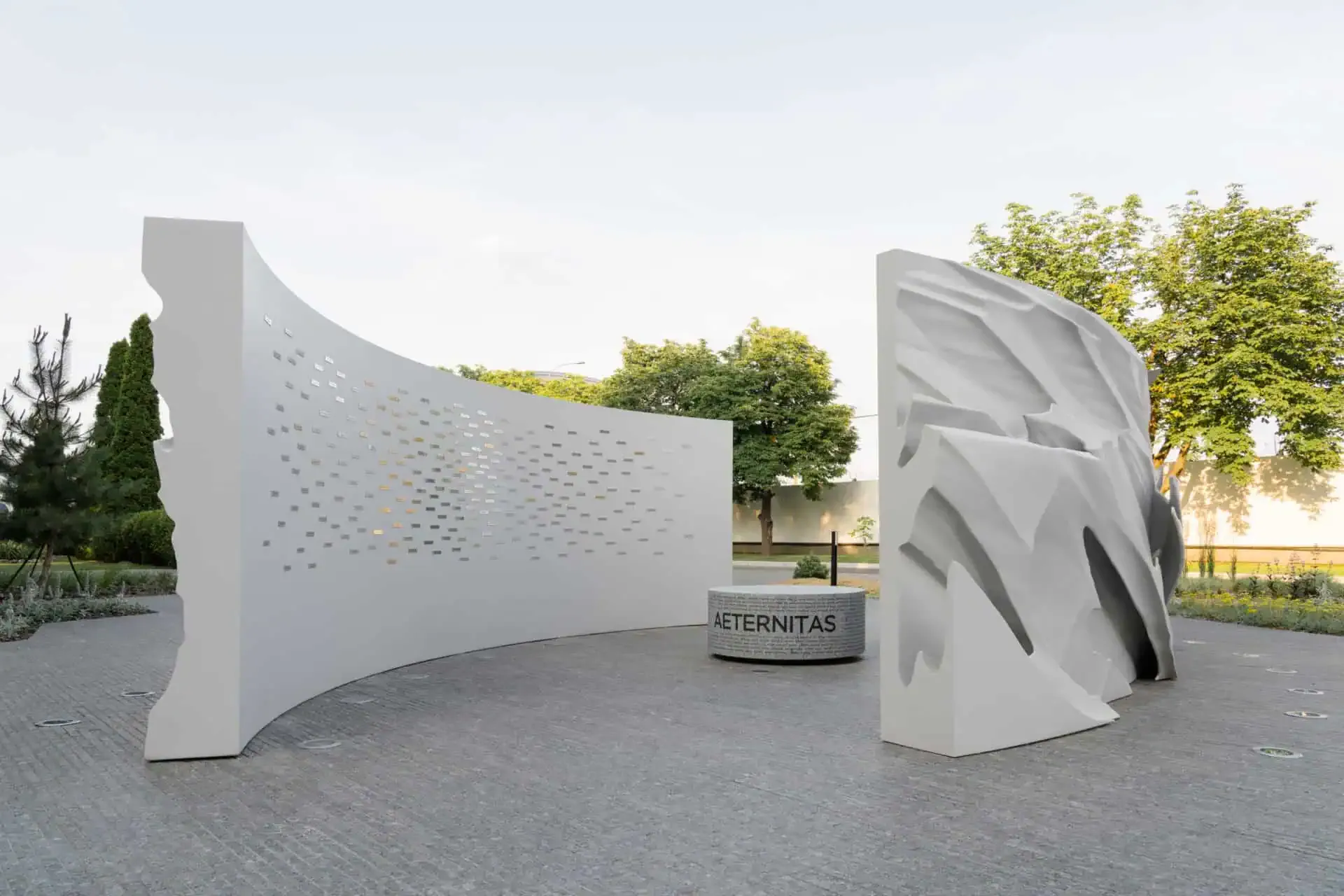 A new memorial for Ukraine's military intelligence members, designed by Nazar Bilyk and built in the courtyard of the Main Intelligence Directorate (HUR) in Kyiv, in June, 2025. (Dmytro Prutkin via Past / Future / Art platform)
A new memorial for Ukraine's military intelligence members, designed by Nazar Bilyk and built in the courtyard of the Main Intelligence Directorate (HUR) in Kyiv, in June, 2025. (Dmytro Prutkin via Past / Future / Art platform)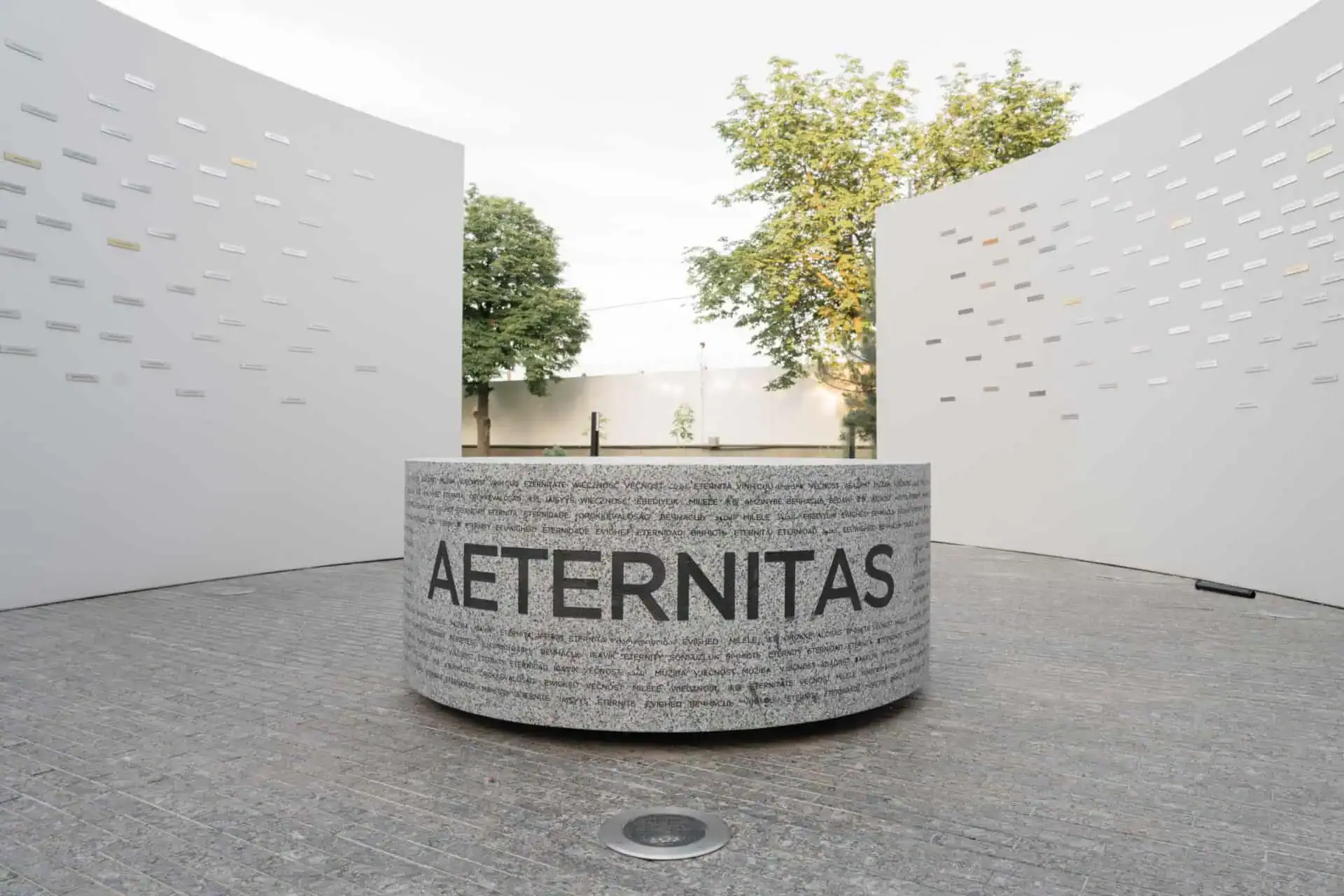 A new memorial for Ukraine's military intelligence members, designed by Nazar Bilyk and built in the courtyard of the Main Intelligence Directorate (HUR) in Kyiv, in June, 2025. (Dmytro Prutkin via Past / Future / Art platform)
A new memorial for Ukraine's military intelligence members, designed by Nazar Bilyk and built in the courtyard of the Main Intelligence Directorate (HUR) in Kyiv, in June, 2025. (Dmytro Prutkin via Past / Future / Art platform)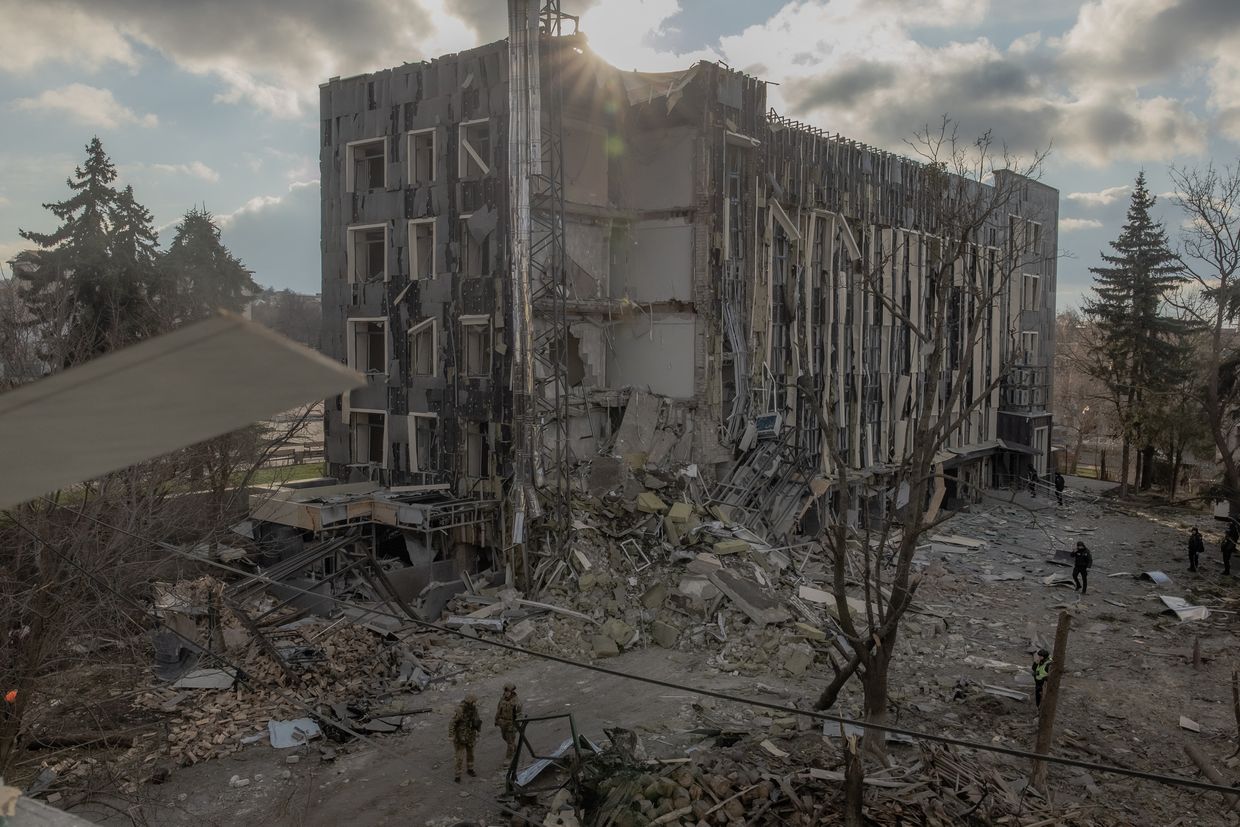 Ukrainian military members inspect a damaged building after a missile attack in Izium, Kharkiv Oblast, on Feb. 4, 2025. (Roman Pilipey/AFP via Getty Images)
Ukrainian military members inspect a damaged building after a missile attack in Izium, Kharkiv Oblast, on Feb. 4, 2025. (Roman Pilipey/AFP via Getty Images)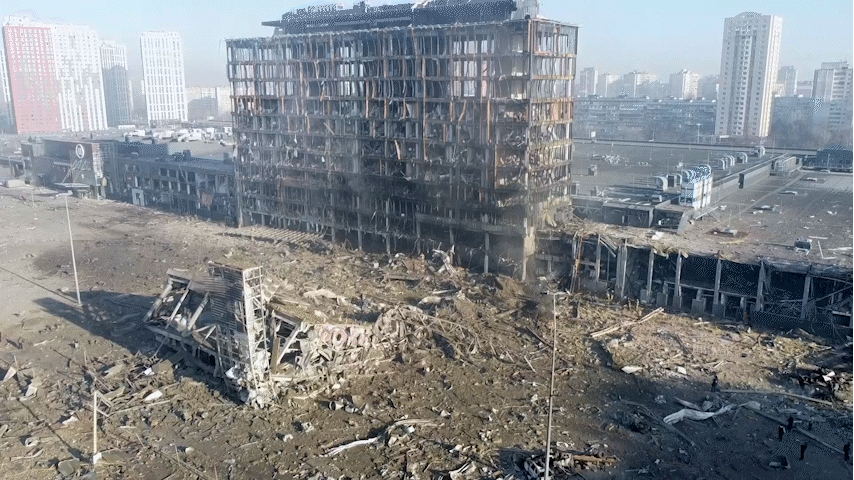 The aftermath of a Russian attack on the Retroville shopping center in Kyiv's central Podil district on March 21, 2022, just under a month after the start of Russia's full-scale invasion of Ukraine. (Servet Ulku /Anadolu Agency via Getty Images)
The aftermath of a Russian attack on the Retroville shopping center in Kyiv's central Podil district on March 21, 2022, just under a month after the start of Russia's full-scale invasion of Ukraine. (Servet Ulku /Anadolu Agency via Getty Images)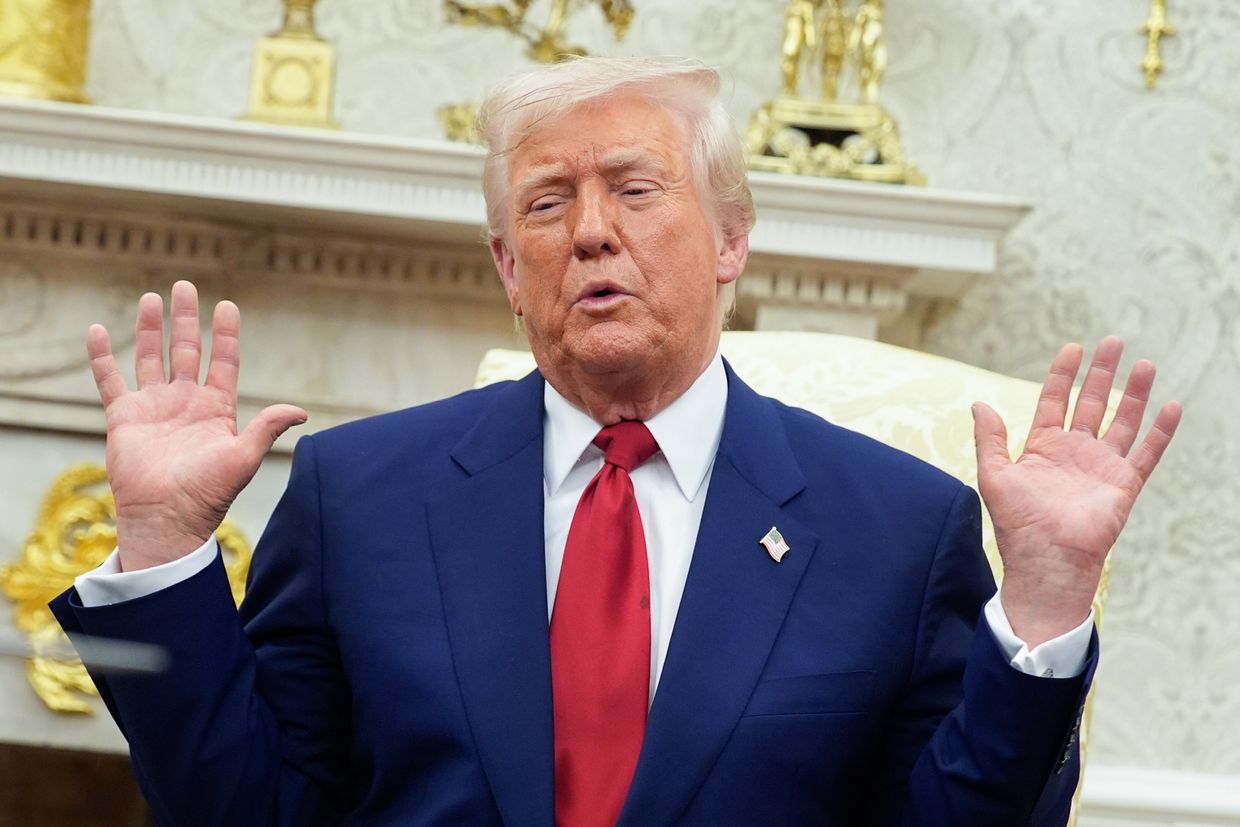 U.S. President Donald Trump during a bilateral meeting with Benjamin Netanyahu, Israel's prime minister, not pictured, in the Oval Office of the White House in Washington, D.C., U.S., on April 7, 2025. (Yuri Gripas/Abaca/Bloomberg via Getty Images)
U.S. President Donald Trump during a bilateral meeting with Benjamin Netanyahu, Israel's prime minister, not pictured, in the Oval Office of the White House in Washington, D.C., U.S., on April 7, 2025. (Yuri Gripas/Abaca/Bloomberg via Getty Images)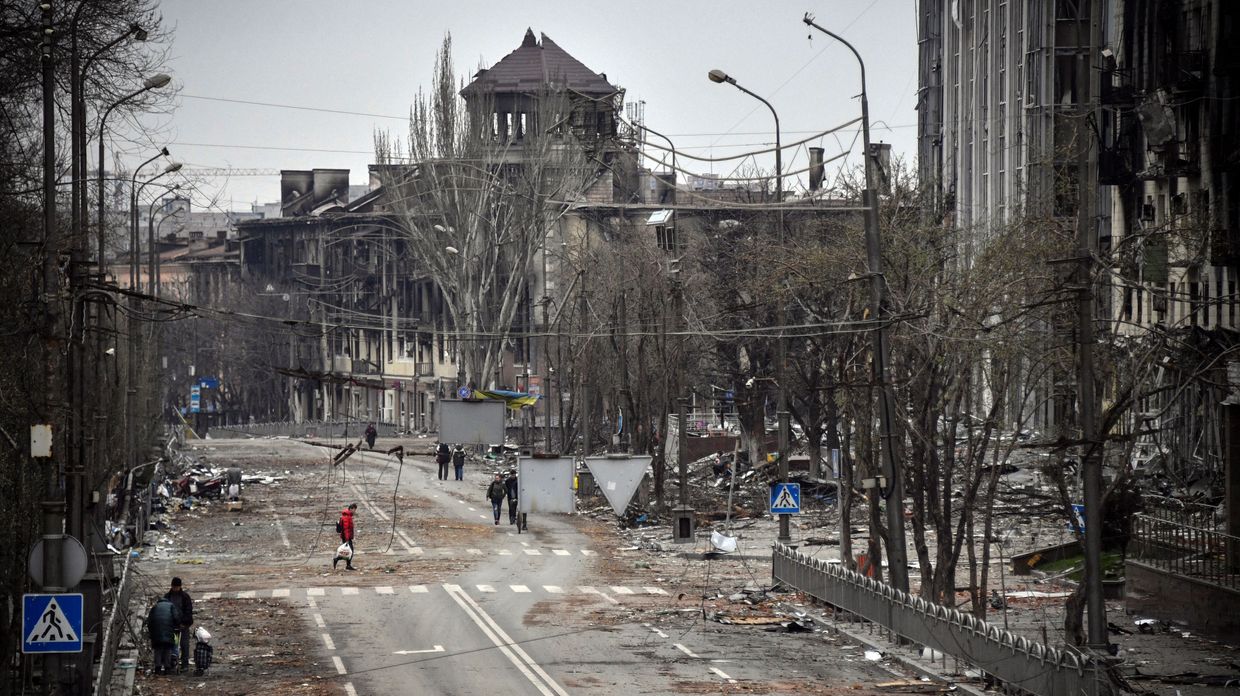 People walk down an avenue in Mariupol, Ukraine, on Apr. 12, 2022, as Russian troops intensify their campaign to capture the strategic port city. (Alexander Nemenov / AFP via Getty Images)
People walk down an avenue in Mariupol, Ukraine, on Apr. 12, 2022, as Russian troops intensify their campaign to capture the strategic port city. (Alexander Nemenov / AFP via Getty Images)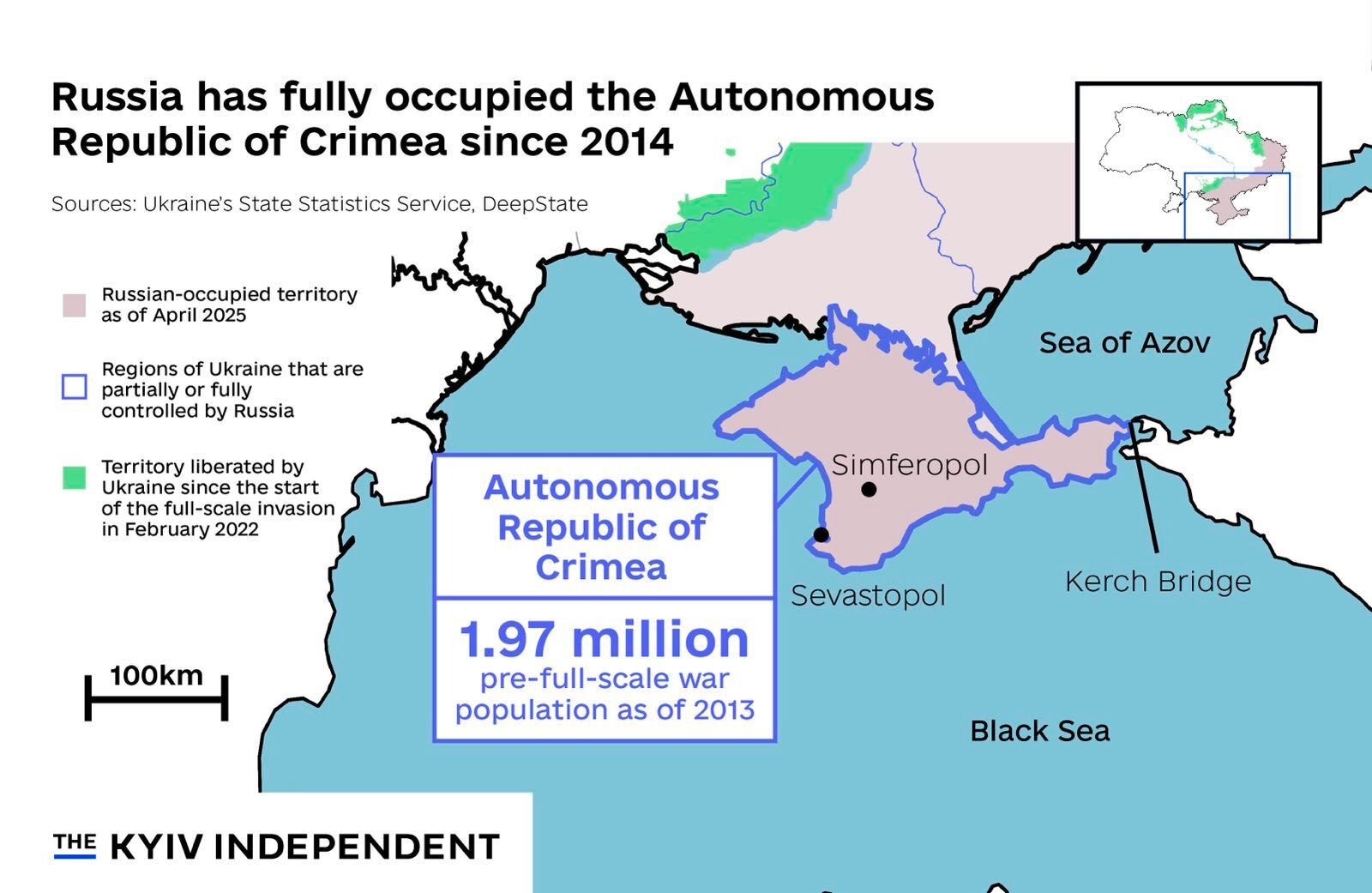 Map of Ukraine's Crimea. (Nizar al-Rifai/The Kyiv Independent***)***
Map of Ukraine's Crimea. (Nizar al-Rifai/The Kyiv Independent***)***